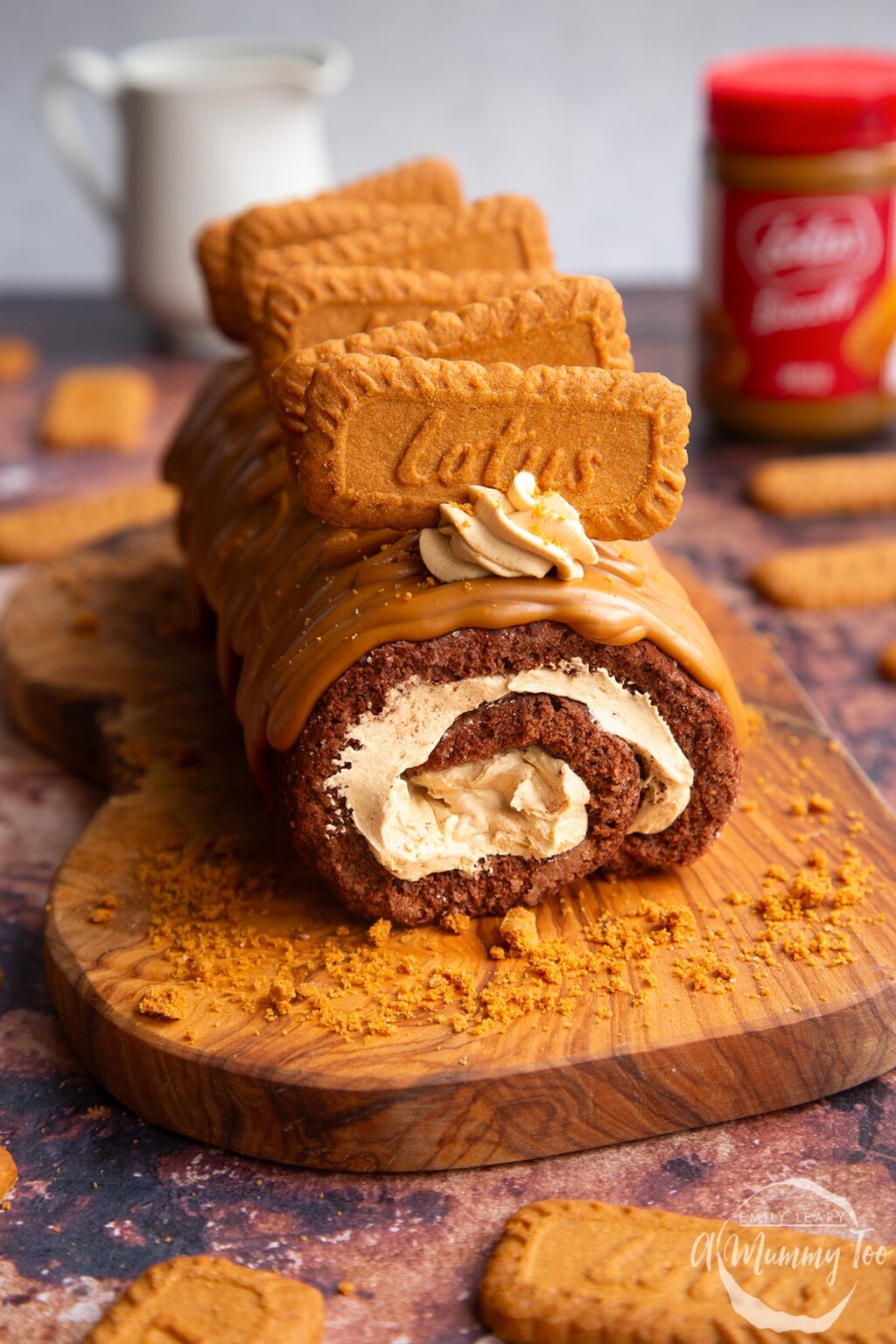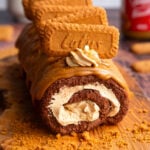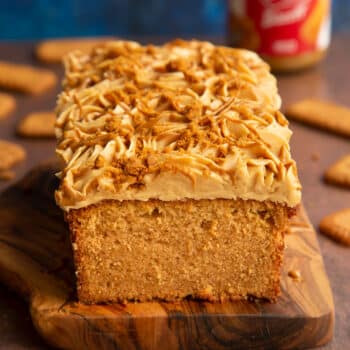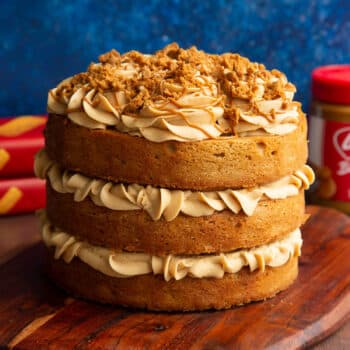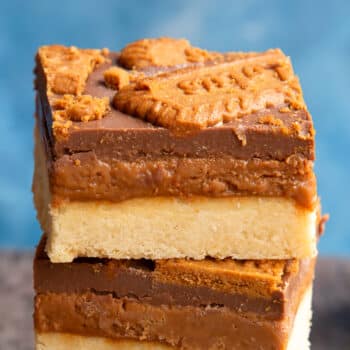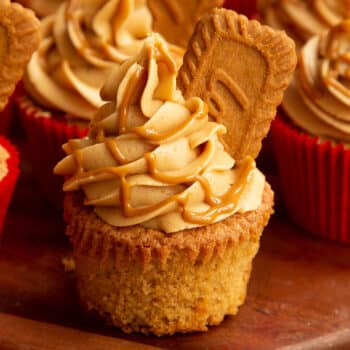This Biscoff Swiss roll is a gorgeously simple, yet stunningly attractive cake that tastes incredible, with a chocolate sponge and Biscoff buttercream.
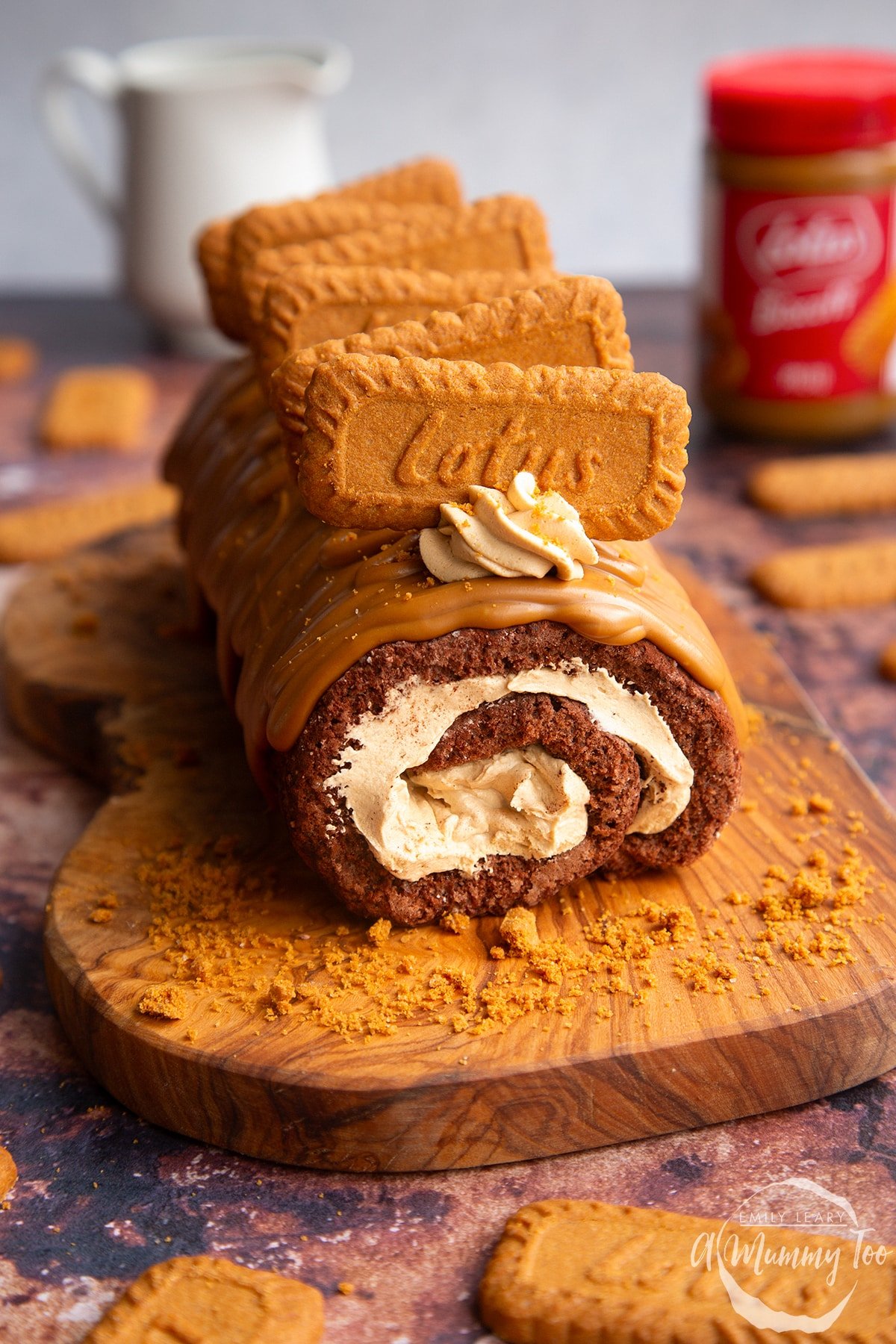
You could make this Biscoff Swiss roll for all sorts of occasions: pot lucks, bake offs, school bake sales, picnics, coffee mornings, and all manner of parties and gatherings.
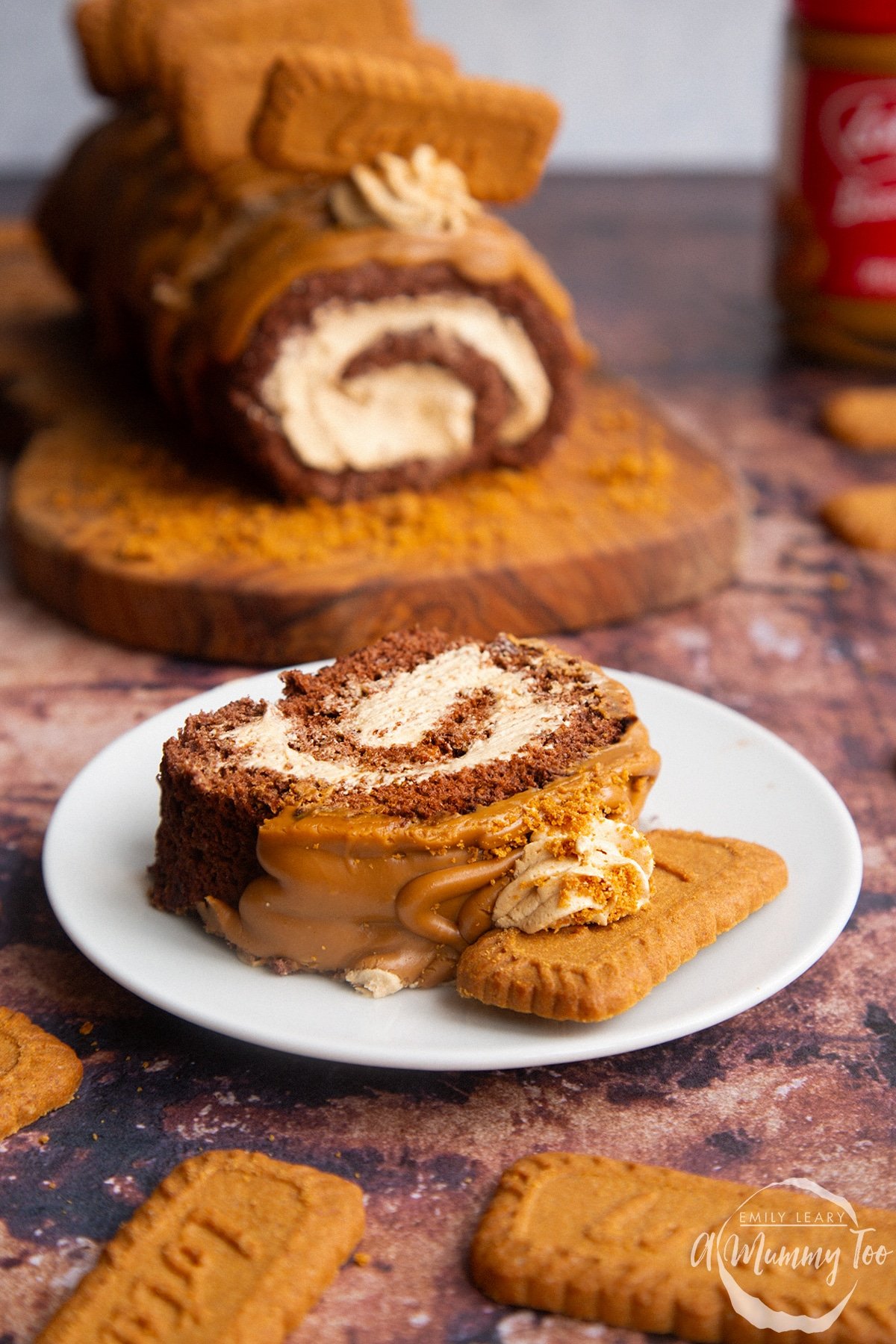
If you have a fan of Biscoff in the family (of course you do!) then this delicious Biscoff cake could even be made for a birthday.
To make this Biscoff Swiss roll, you’ll with the tender, rich chocolate sponge, whisking eggs and sugar together until pale and creamy, then folding in cocoa and flour.
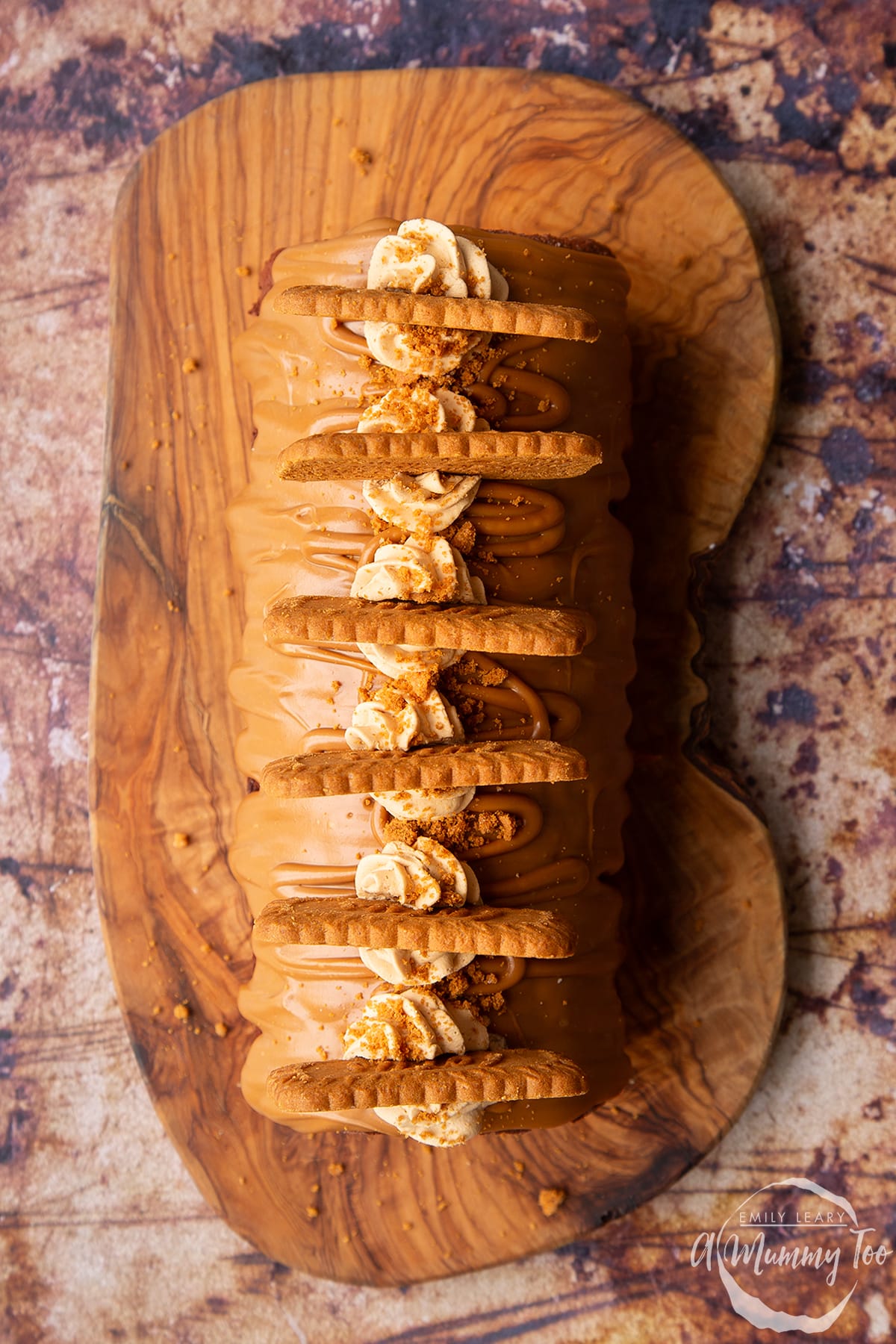
You’ll then pour your chocolate sponge batter into a lined Swiss roll tin and bake for 8 minutes until firm, light and airy.
The trick to creating a Swiss roll that actually rolls without cracking is to roll it up (without the filling!) while it’s still warm, so I’ve included instructions and photographs below to help you do just that.
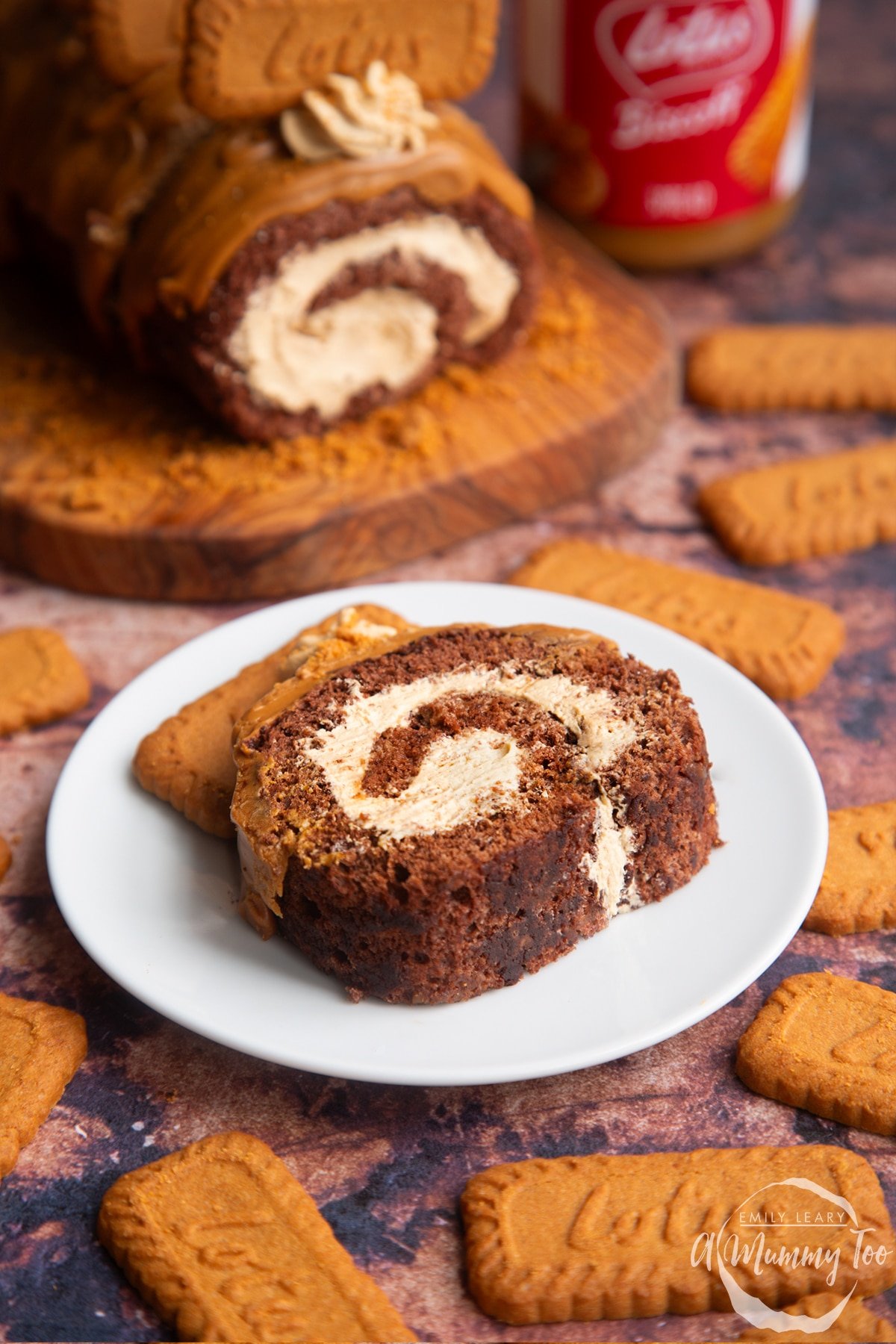
You then make a really simple Biscoff buttercream but whisking butter, icing sugar, Biscoff smooth spread and a splash of milk together until beautifully smooth and creamy.
With the sponge cooled, you’ll gently unroll it and spread it with the Biscoff buttercream before rolling back up.
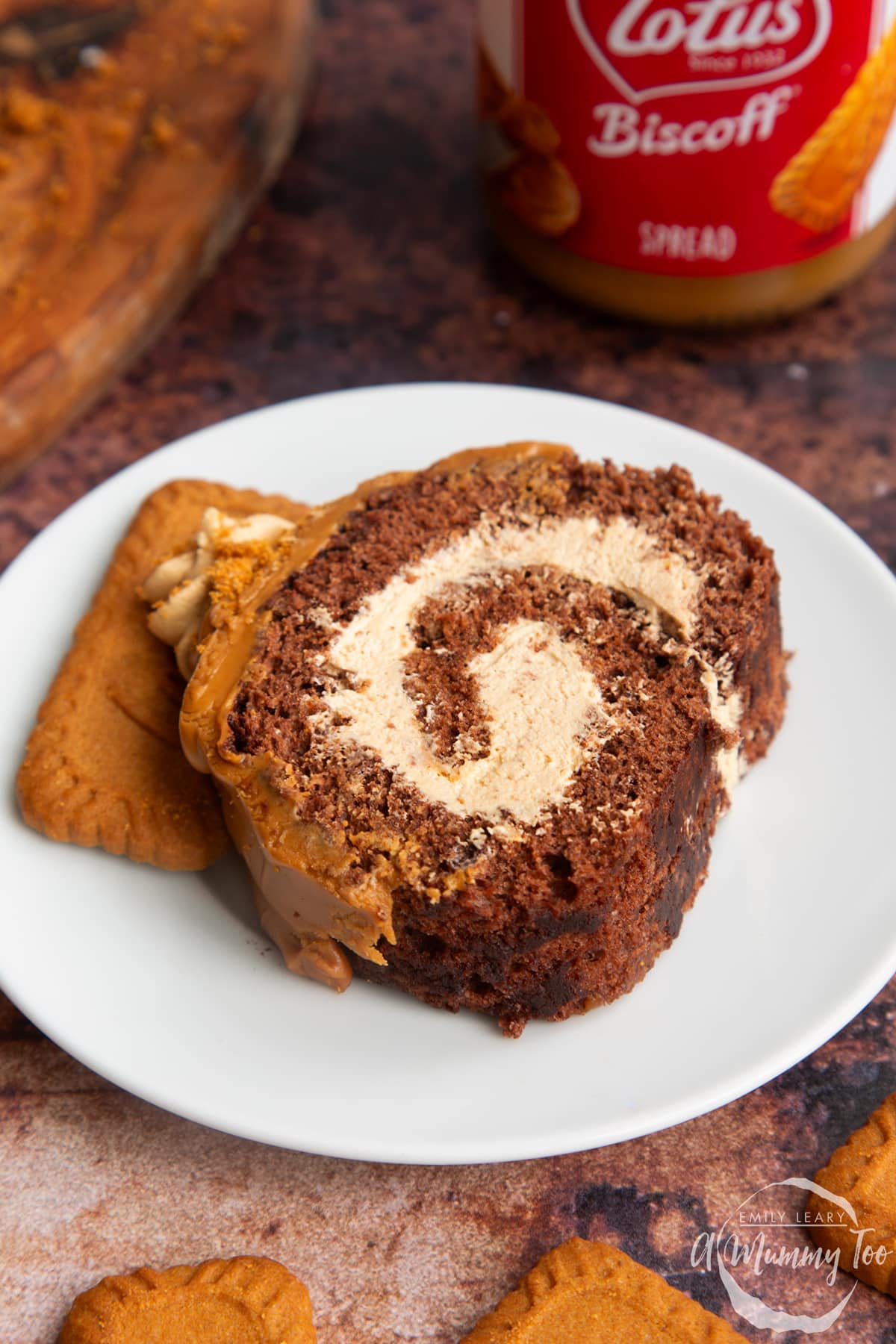
The result is really quite show stopping and it guaranteed to make for an eye-catching centrepiece.
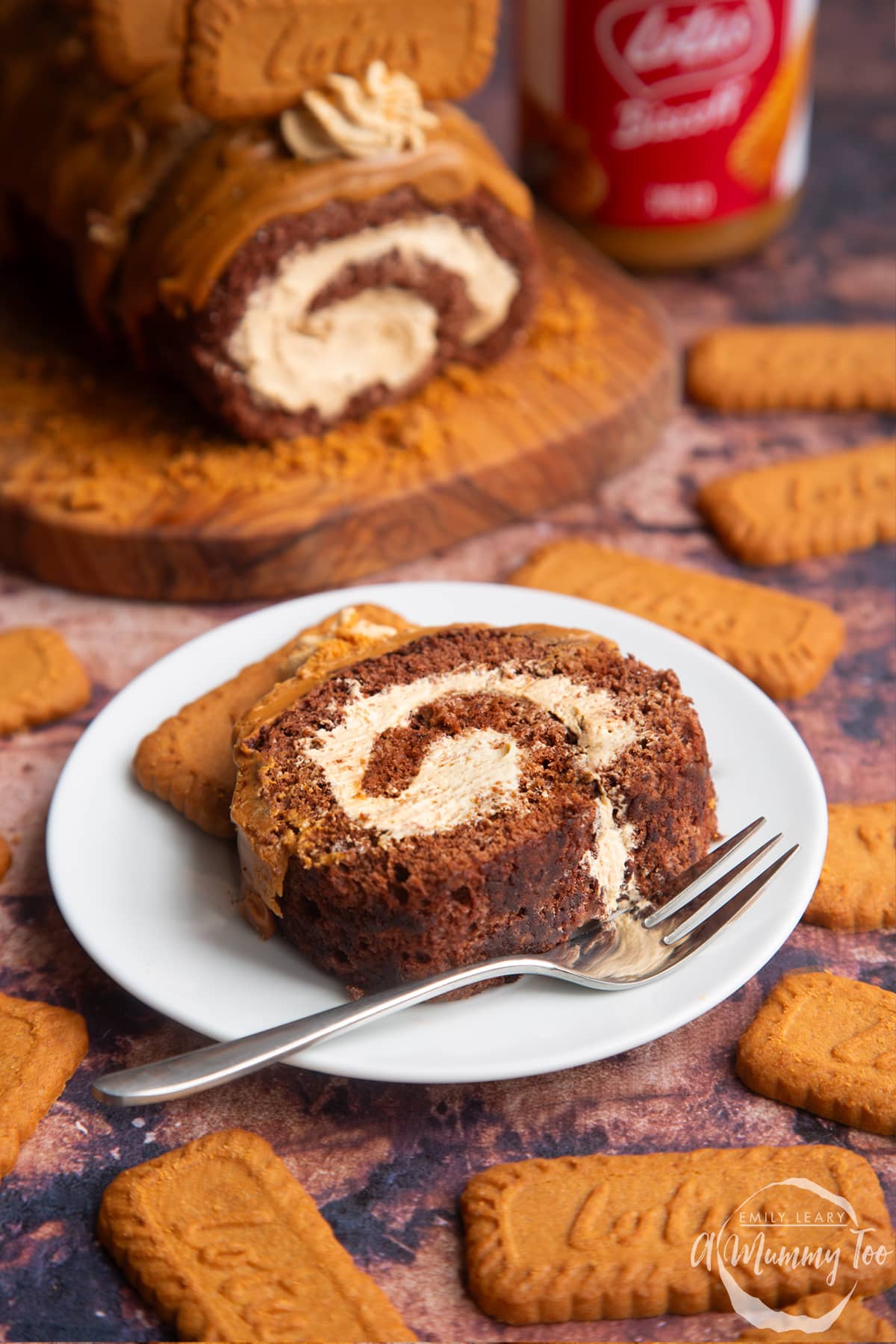
Is Biscoff Swiss roll easy to make?
There are a few elements to this cake but they’re all very straightforward with simple ingredients, and putting it all together is great fun.
I recommend reading the full recipe before you start so that you know exactly what’s required, and then getting out all the ingredients so that you have them on hand. You can even measure them all out, if you like, to allow you to focus on the process.
Despite being a bit different to a typical sponge, Swiss roll sponge is actually really easy to make – and cooks super fast, so you can make your Swiss roll in no time.
Read on for the full recipe with detailed instructions and a helpful photograph for every step. And if you have any questions, just leave me a comment. Enjoy!
What goes well with Biscoff Swiss roll?
This recipe is a decadent treat all by itself, but you could serve with a dollop of vanilla ice cream, if you want to make the celebrations extra special.
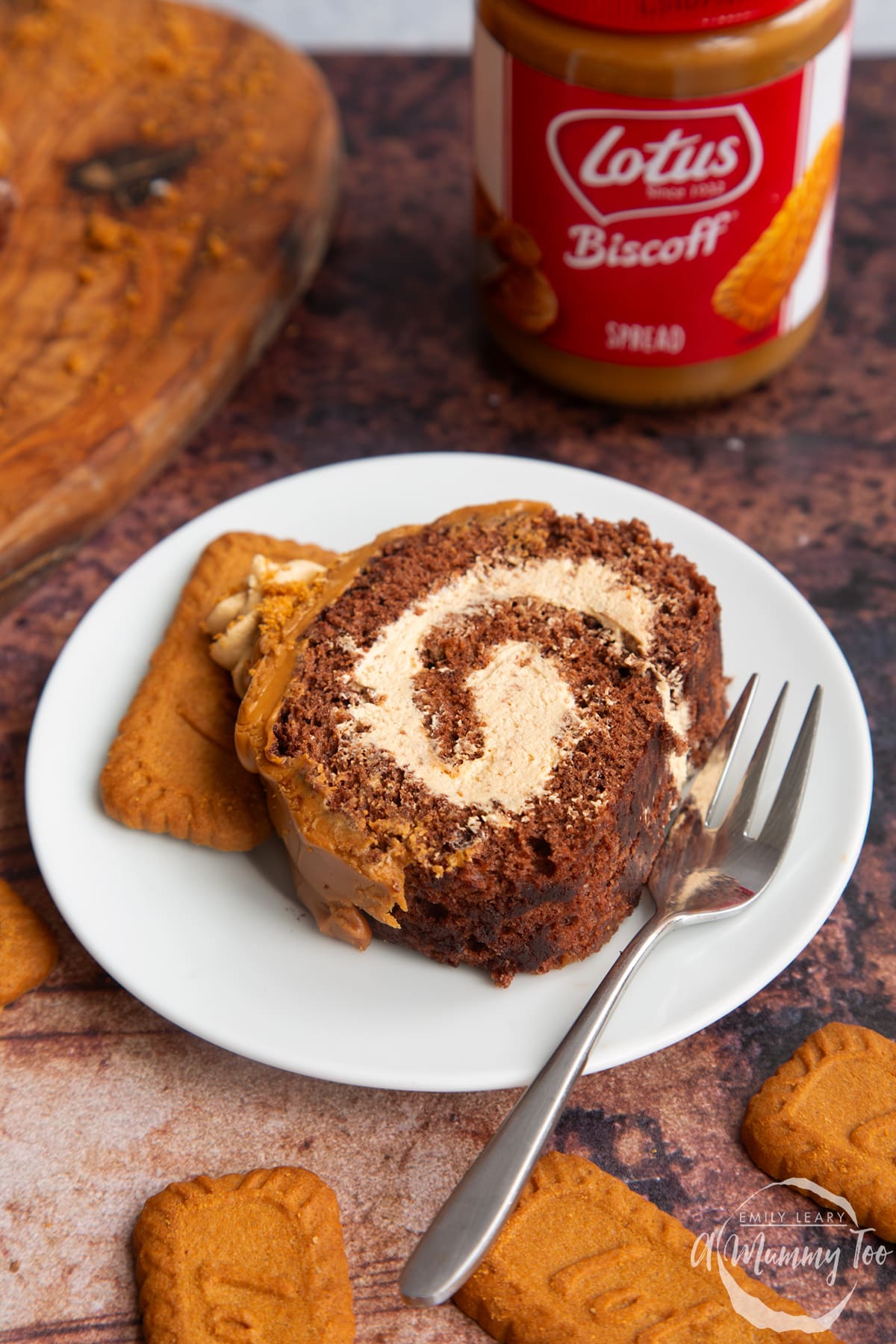
Ingredients
For the sponge
- 3 medium free range eggs
- 100 g (½ cup + 1tbsp) white caster sugar (superfine sugar)
- 100 g (⅔ cup) self-raising white flour (self rising flour)
- 2 tbsp icing sugar (powdered sugar)
To dust
- 1 tbsp cocoa powder (dutch processed)
- 1 tbsp icing sugar (powdered sugar)
For the Biscoff frosting filling
- 100 g (7 tbsp) butter
- 100 g (¾ cup) icing sugar (powdered sugar)
- 100 g (⅓ cup) Lotus biscoff spread smooth
- 1 tbsp milk
To decorate
- 150 g (½ cup) Lotus biscoff spread smooth
- 7 Lotus Biscoff caramelised biscuits
Can I make this Biscoff Swiss roll recipe without buttercream?
You could fill the inside of your Swiss cream with whipped cream instead of buttercream if you like. Check out Mary Berry’s chocolate roulade for the filling recipe.
Bear in mind, though, that if the Biscoff Swiss roll is filled fresh cream, it will need to be kept in the refrigerator, where it will keep for up to 2 days, rather than the 5 days it will keep with a buttercream filling.

Will I need any special equipment for to make this Biscoff Swiss roll recipe?
You’ll probably have everything you need for this cake in your kitchen already, such as weighing scales and measuring spoons, a mixing bowl and a silicon spatula.
An electric whisk is recommended as you need to whip the eggs and sugar together until they’re really thick, pale and increased in volume. Even with an electric whisk, this takes a couple of minutes, so with a manual whisk you would get a very tired arm. It’s not impossible though!
You’ll need a tin to bake your sponge in. I recommend a nonstick Swiss roll tin, measuring 23cm x 33cm (9 inch x 13 inch). Swiss roll tins have shallow, straight sides, which makes them perfect for the job, but any similar size tray will do as long as it roughly fits that description.
Finally, you’ll a piping bag and open star piping tip if you want to add the little buttercream rosettes on top.
There is a full list of suggested equipment on the recipe card below.
Where can I buy piping bags and nozzles?
You can usually find piping bags in your local supermarket. They’re often hanging between shelves or at the end of the baking aisle.
You can usually buy reusable piping bag and nozzle sets, which are usually more cost effective and eco friendly. Or you can buy disposable piping bags, which can still be washed and reused a few times over.
If you just want to buy the piping tip, you’ll need an open star piping tip like this, which you should be able to find in any baking store.
And once you’ve given the recipe a go, I’d love you to come back and leave a comment letting me know how yours turned out.
I’d love to see your videos and pics, too! Just tag me on social media. I’m @emilylearycooks on Twitter and TikTok or @amummytoo on Instagram.
Can I make this Biscoff Swiss roll in a stand mixer such as a KitchenAid or Kenwood Mixer?
It takes a couple of minutes with an electric whisk to get the eggs and sugar well whipped, pale and fluffy, so you could certainly use a stand mixer with balloon whisk attachment for this stage, if you like. When it comes to folding the flour and cocoa into the sponge, it’s really important to do this gently by hand of you’ll knock all the air back out of the mix.
You can make the whole buttercream recipe in a stand mixer with balloon whisk attachment. Be sure to start slow so that you don’t end up in a cloud of icing sugar!
Can I make this Biscoff Swiss roll with a food processor?
No, the blades of a food processor will not whip the required air into the sponge or buttercream, so it is not a suitable piece of equipment for this recipe.
Can I make this recipe in a normal cake tin?
This sponge recipe isn’t really designed to be cooked in a normal cake tin. If you’d prefer to make a round cake, I’d recommend swapping to something like this chocolate sponge.
It uses the same buttercream as this Swiss roll recipe!
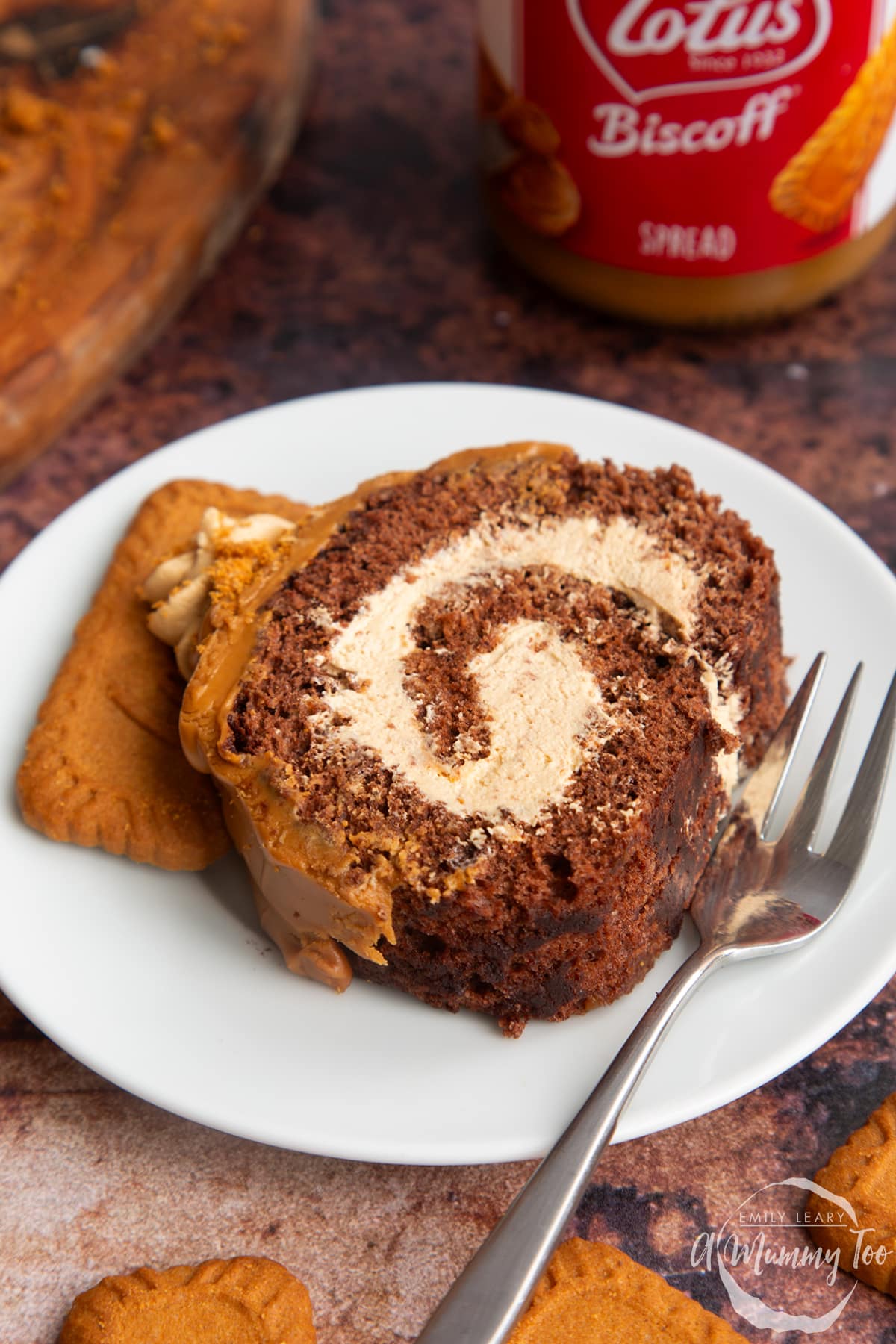
Full Step-By-Step Instructions
Make the Swiss roll sponge
Line the Swiss roll tray with baking paper and preheat the oven to 200C (180C fan).
Put the eggs and caster sugar in a large mixing bowl.
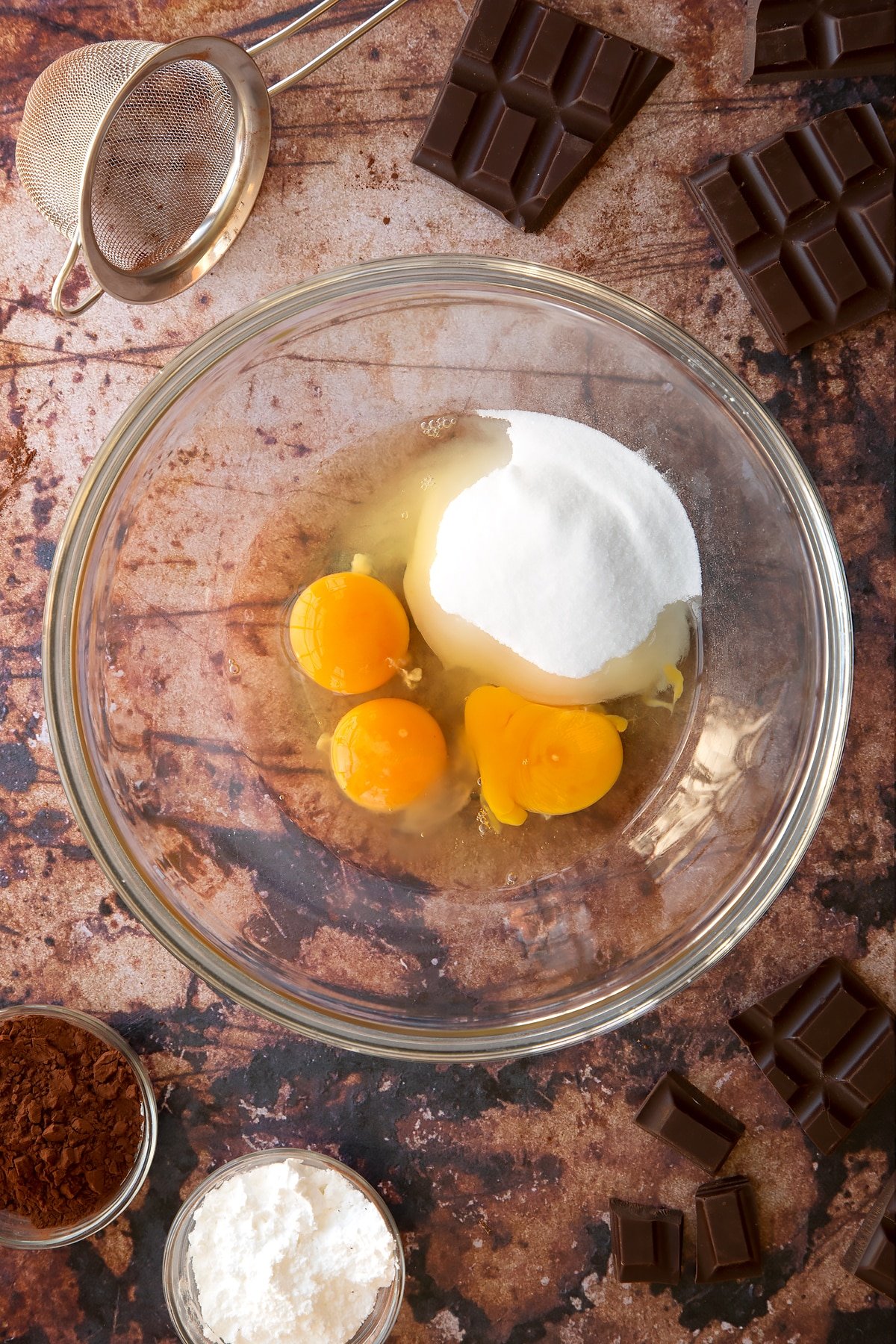
Whisk until thick, pale and considerably increased in volume.
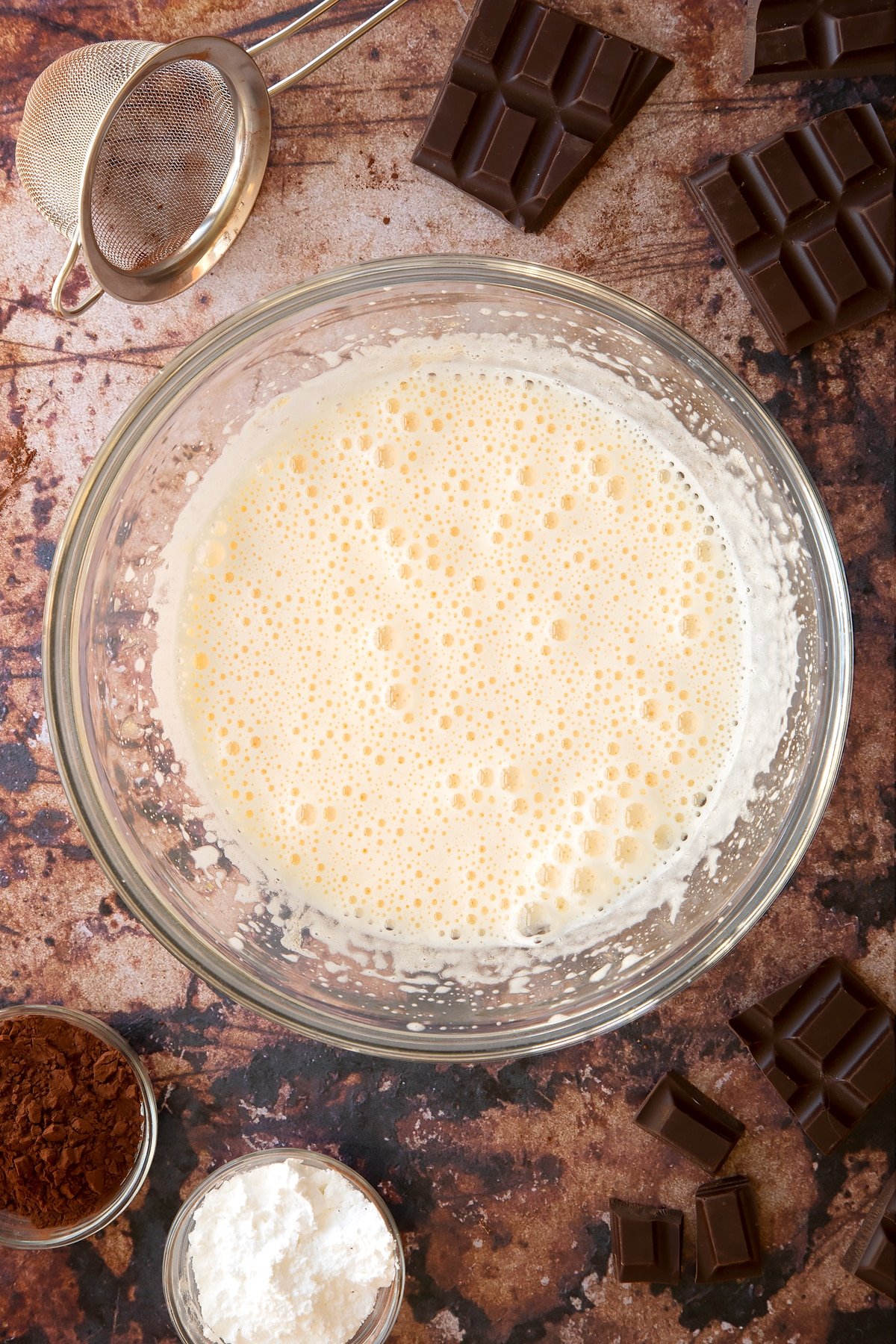
Sift in the flour and cocoa.
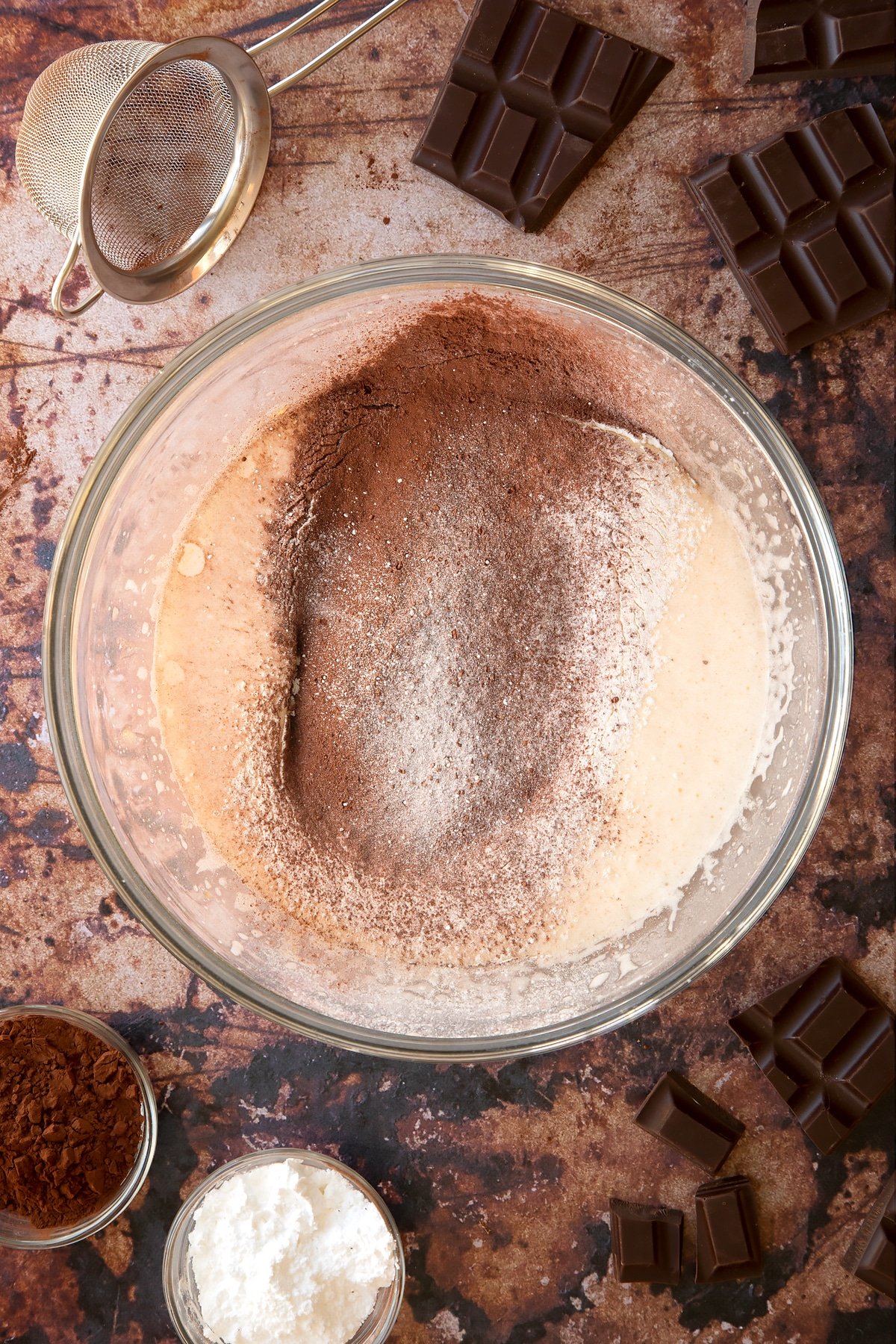
Fold through gently with a silicon spatula.
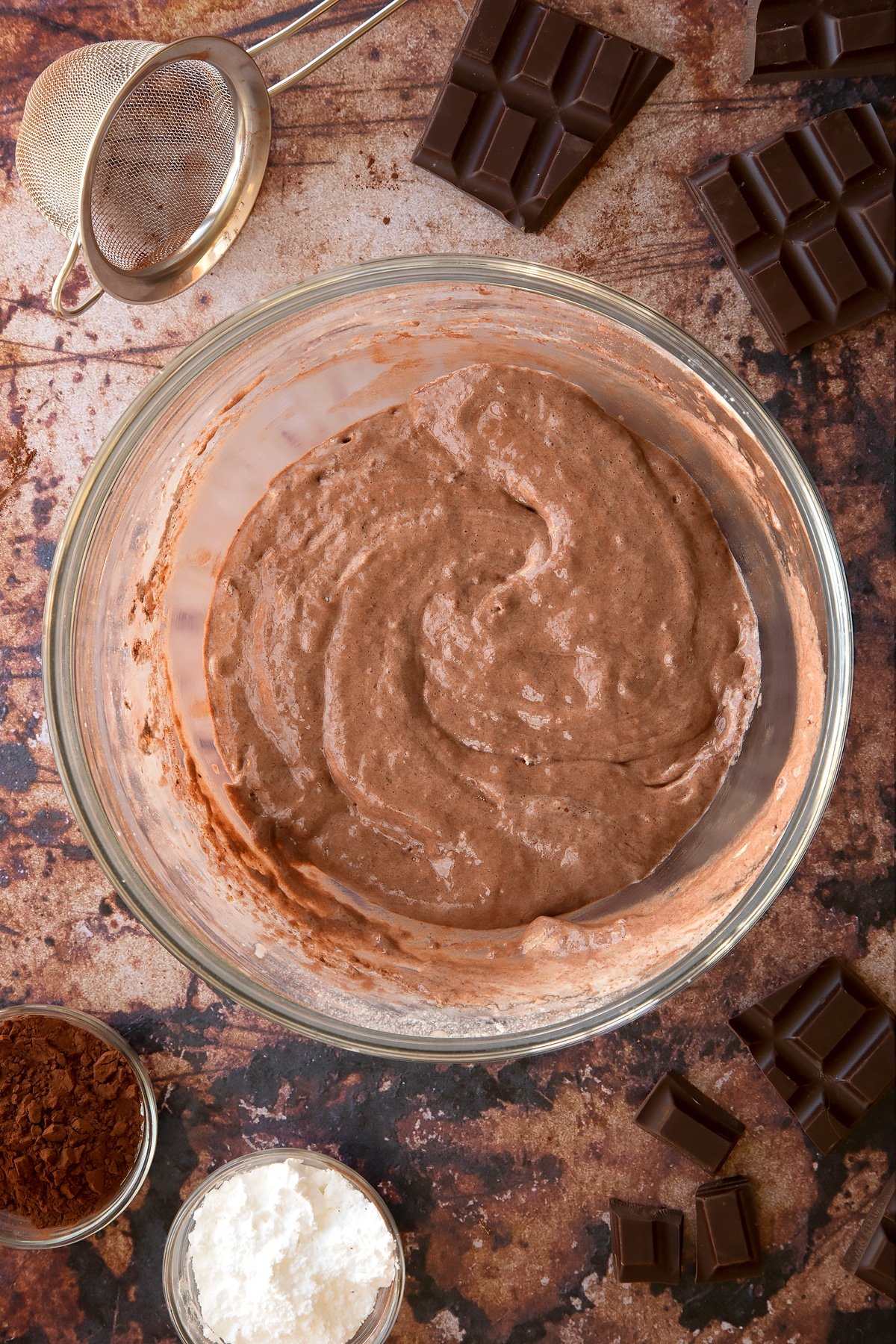
Tip the mixture into the lined tin and gently level off.
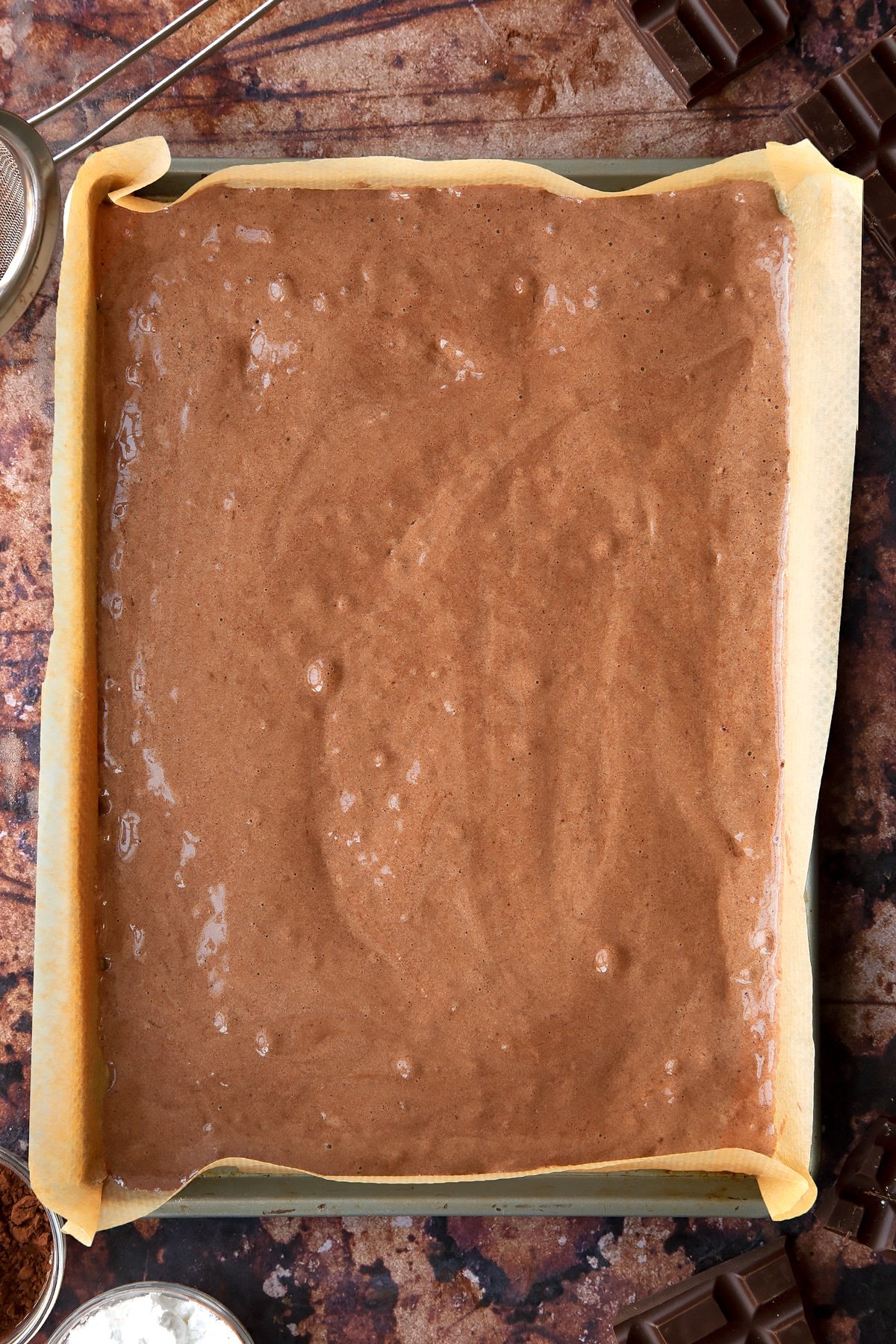
Bake for 8 minutes until just firm.

Pre-shape the Swiss roll sponge
Lay a rectangle of baking paper out on your counter. Sift the cocoa and icing sugar all over the paper.
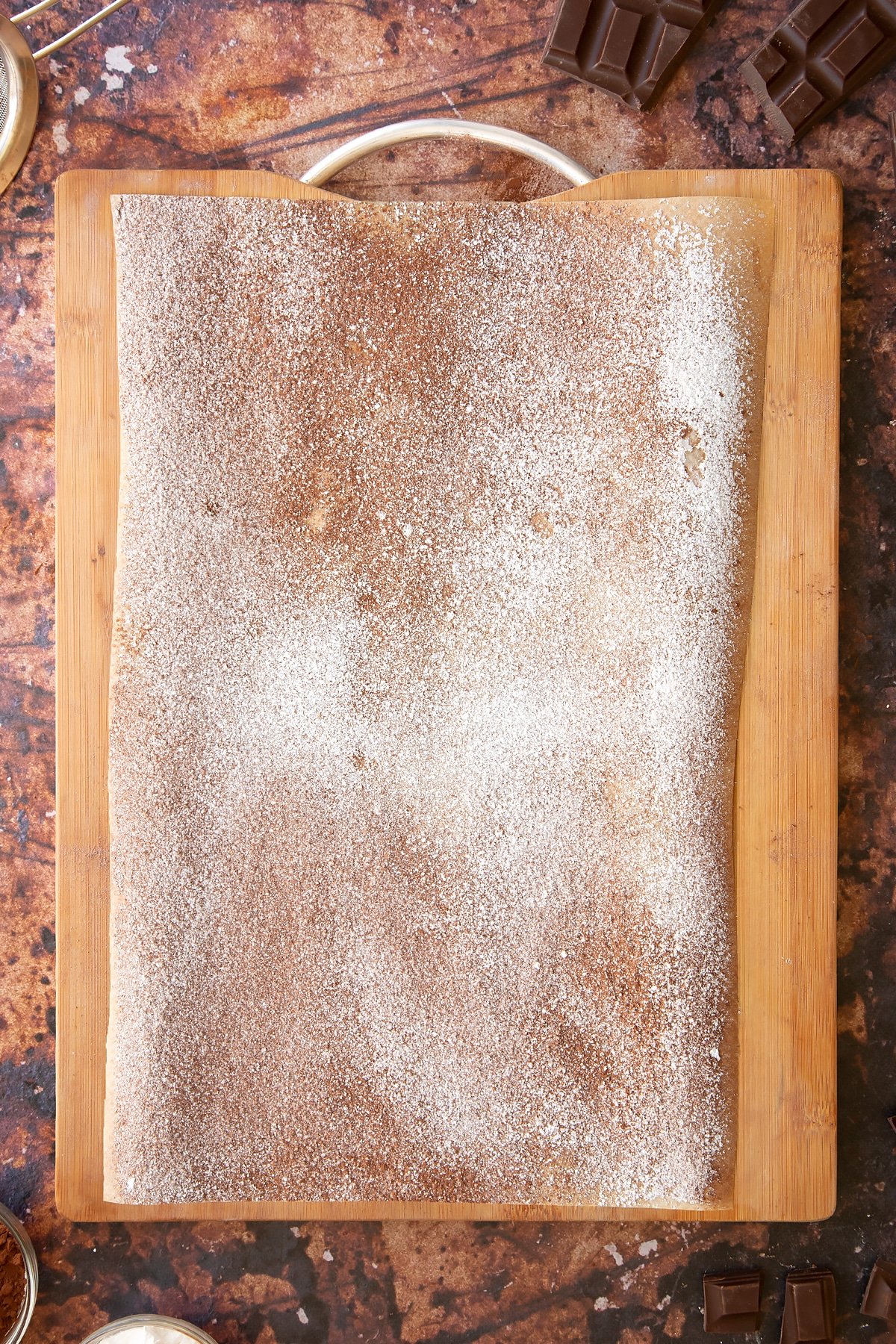
Turn the hot Swiss roll sponge out onto the baking paper.
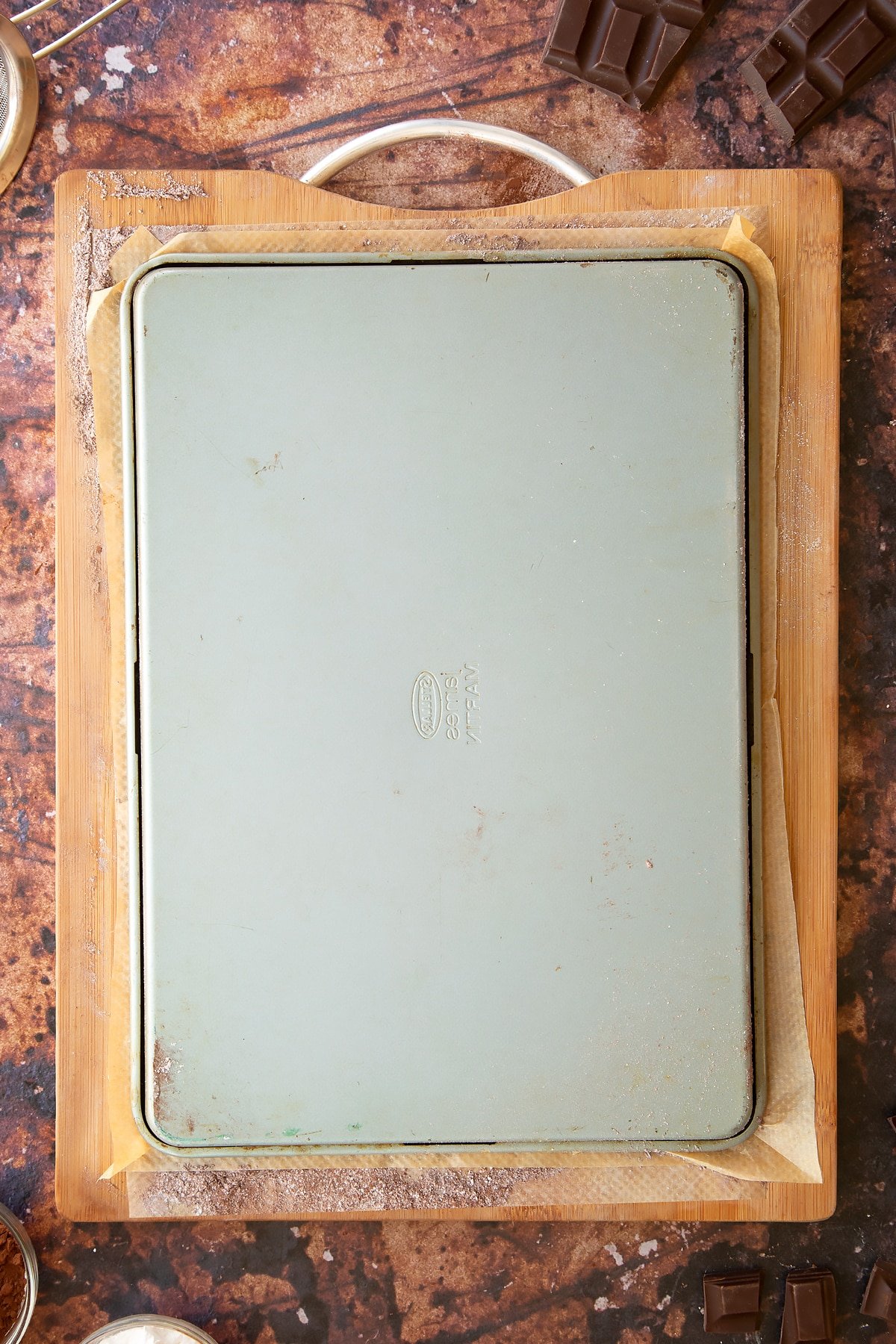
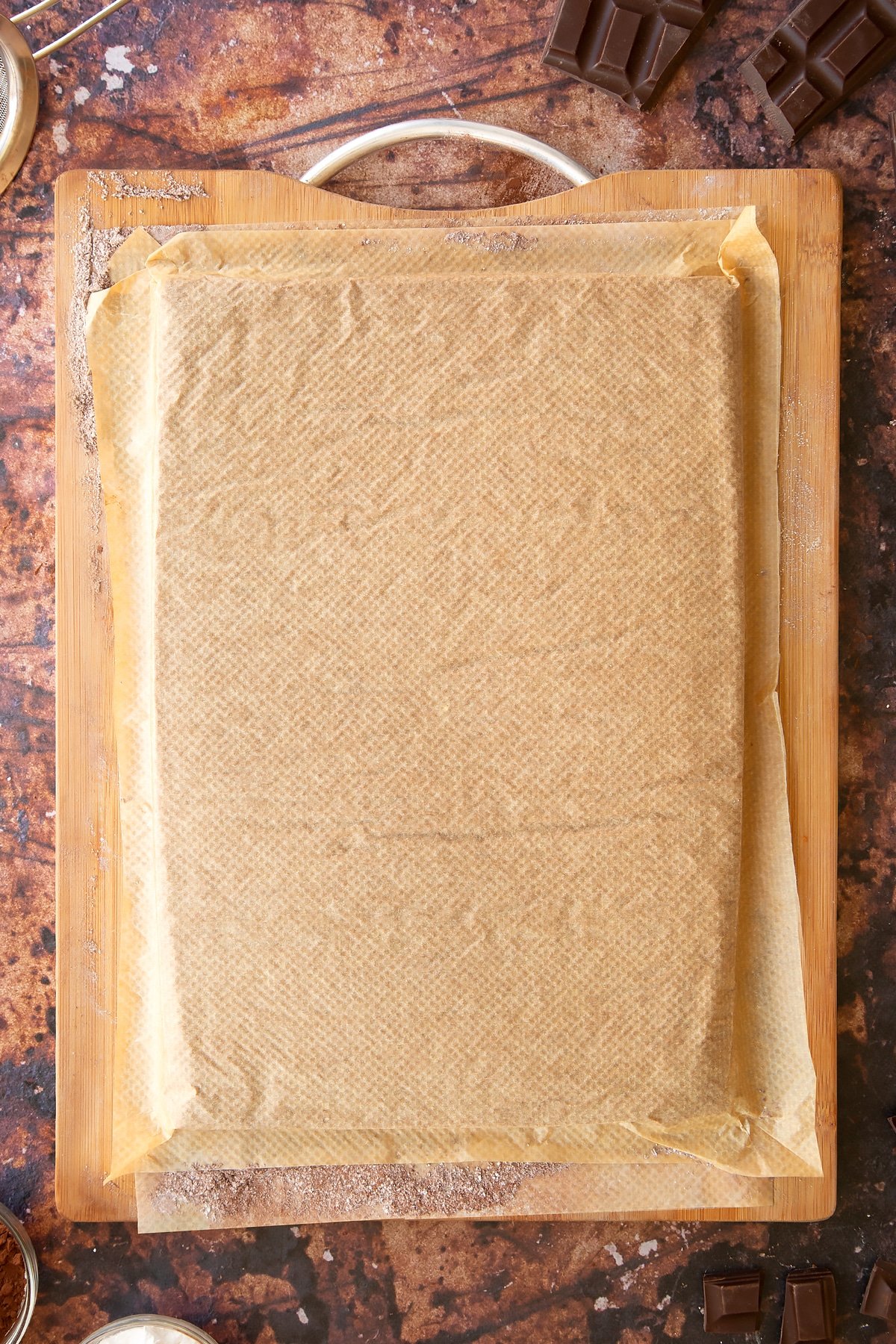
Carefully peel off the paper backing.
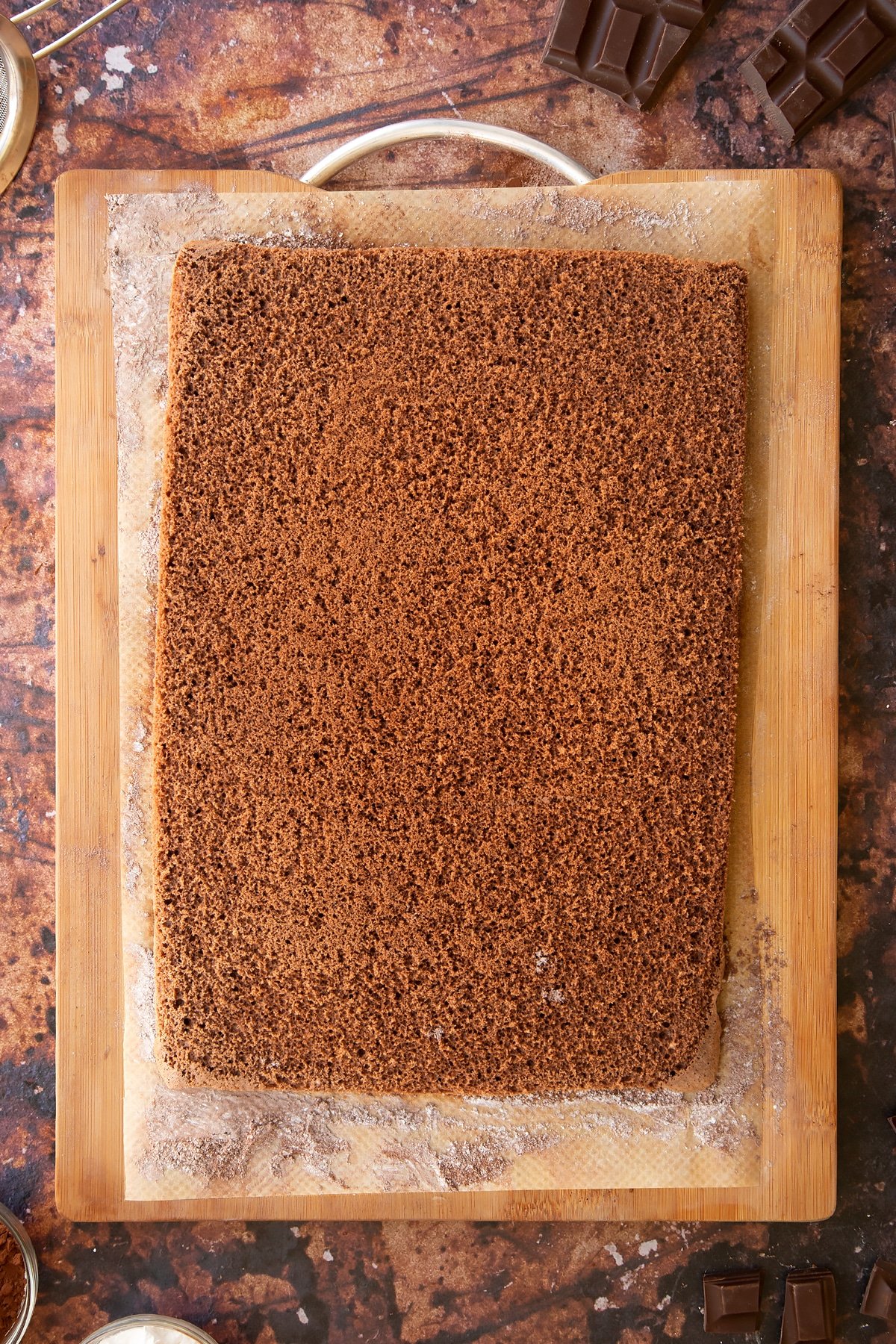
Lay a clean tea towel on top of the Swiss roll sponge.
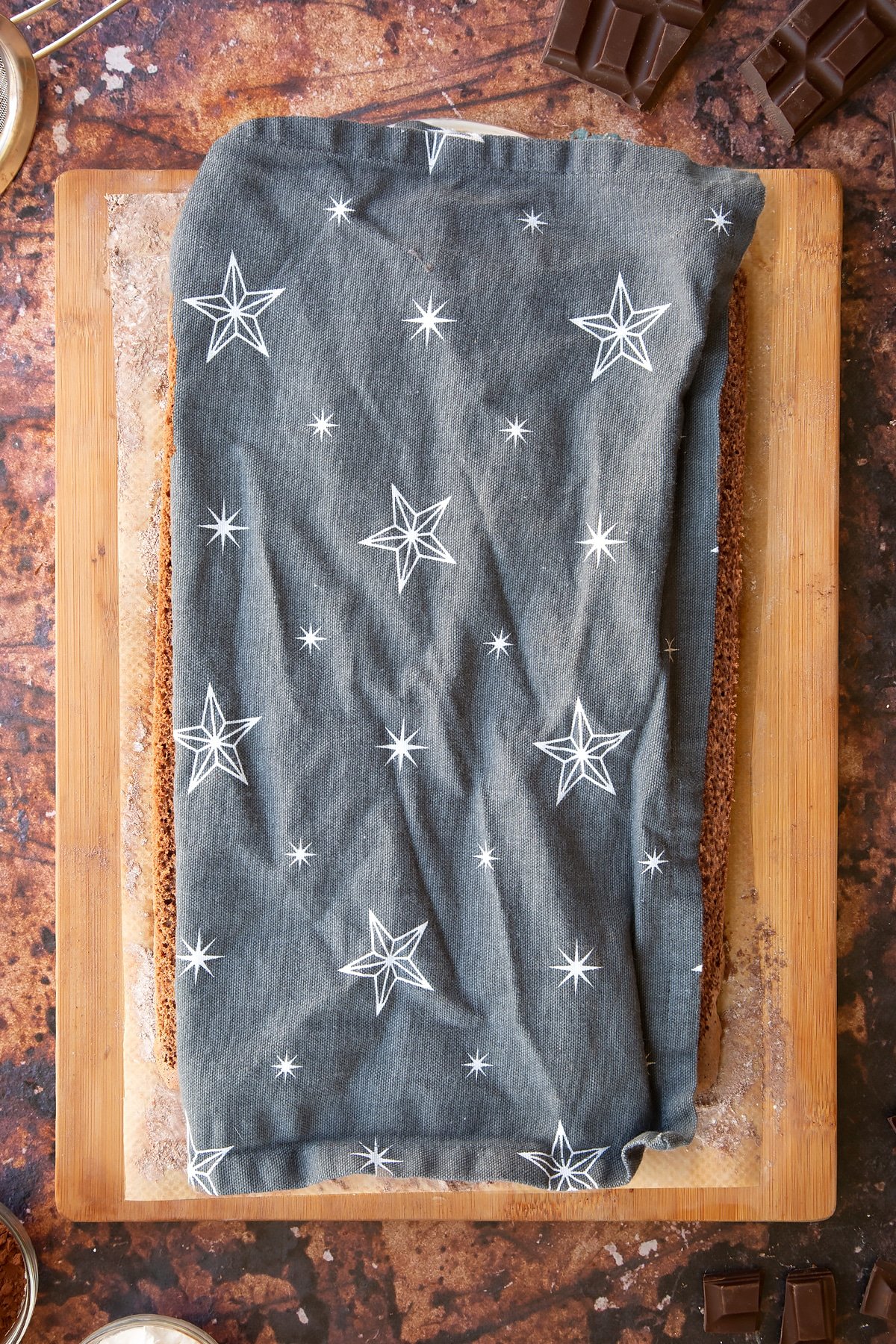
Carefully roll the sponge up with the tea towel and baking paper. Leave rolled up to cool completely.
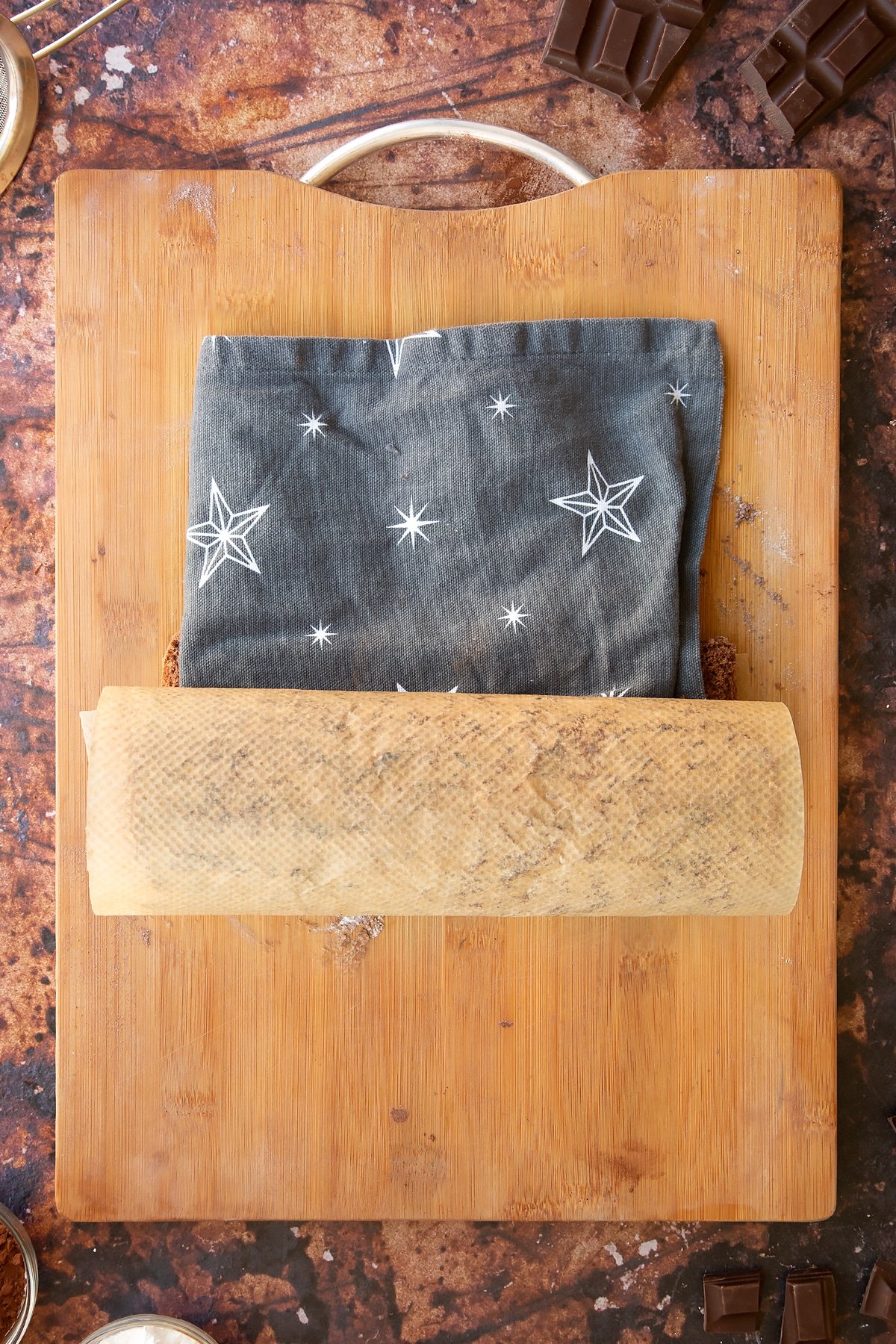
Make the Biscoff frosting
Put the butter, Biscoff, butter and milk in a large bowl.
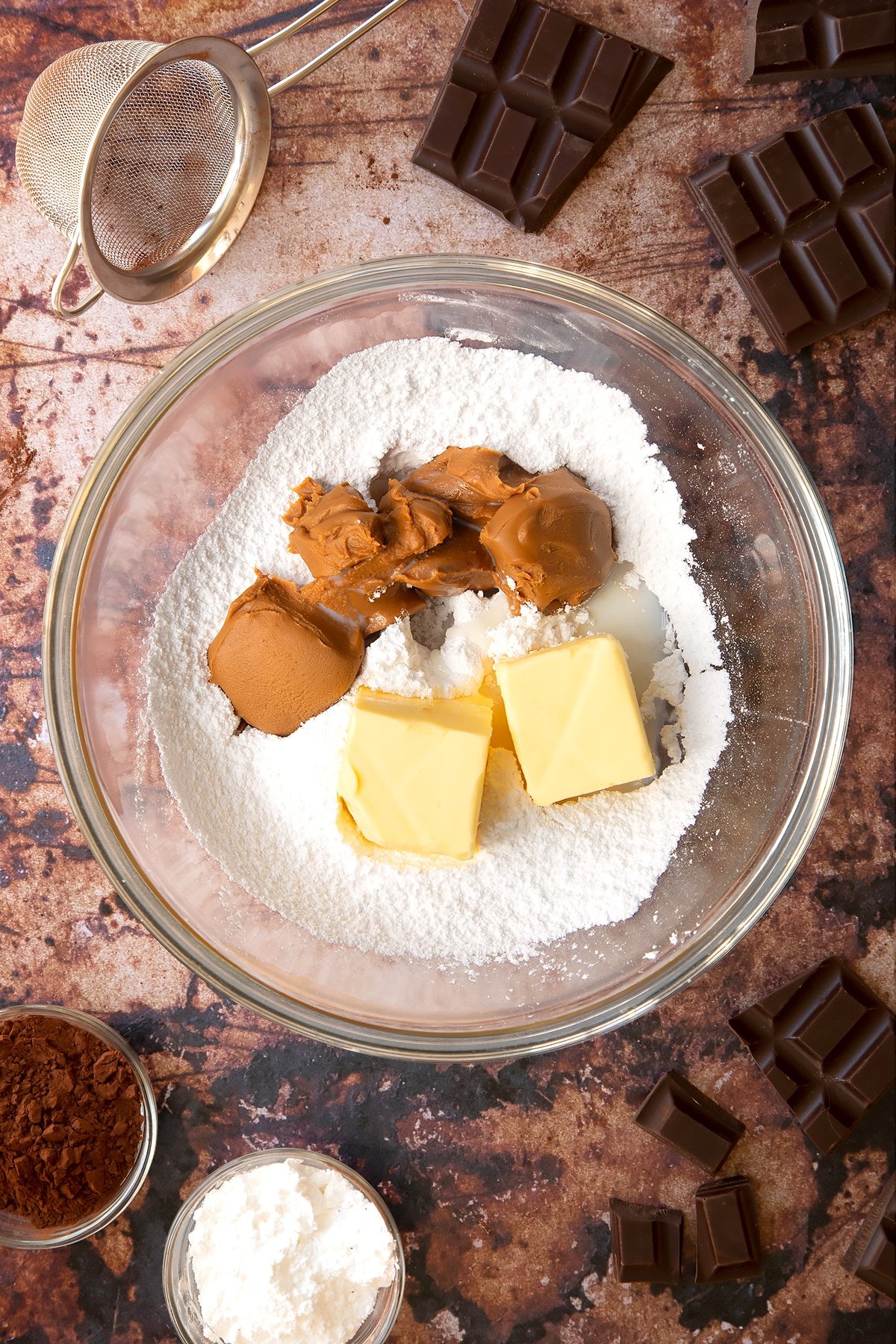
Whisk until pale and creamy.

Fill the Biscoff Swiss roll
Carefully unroll the totally cooled sponge.
Spoon approximately 2/3 of the frosting on top, spreading to the edges.

Roll back up, this time without taking the baking paper with it.
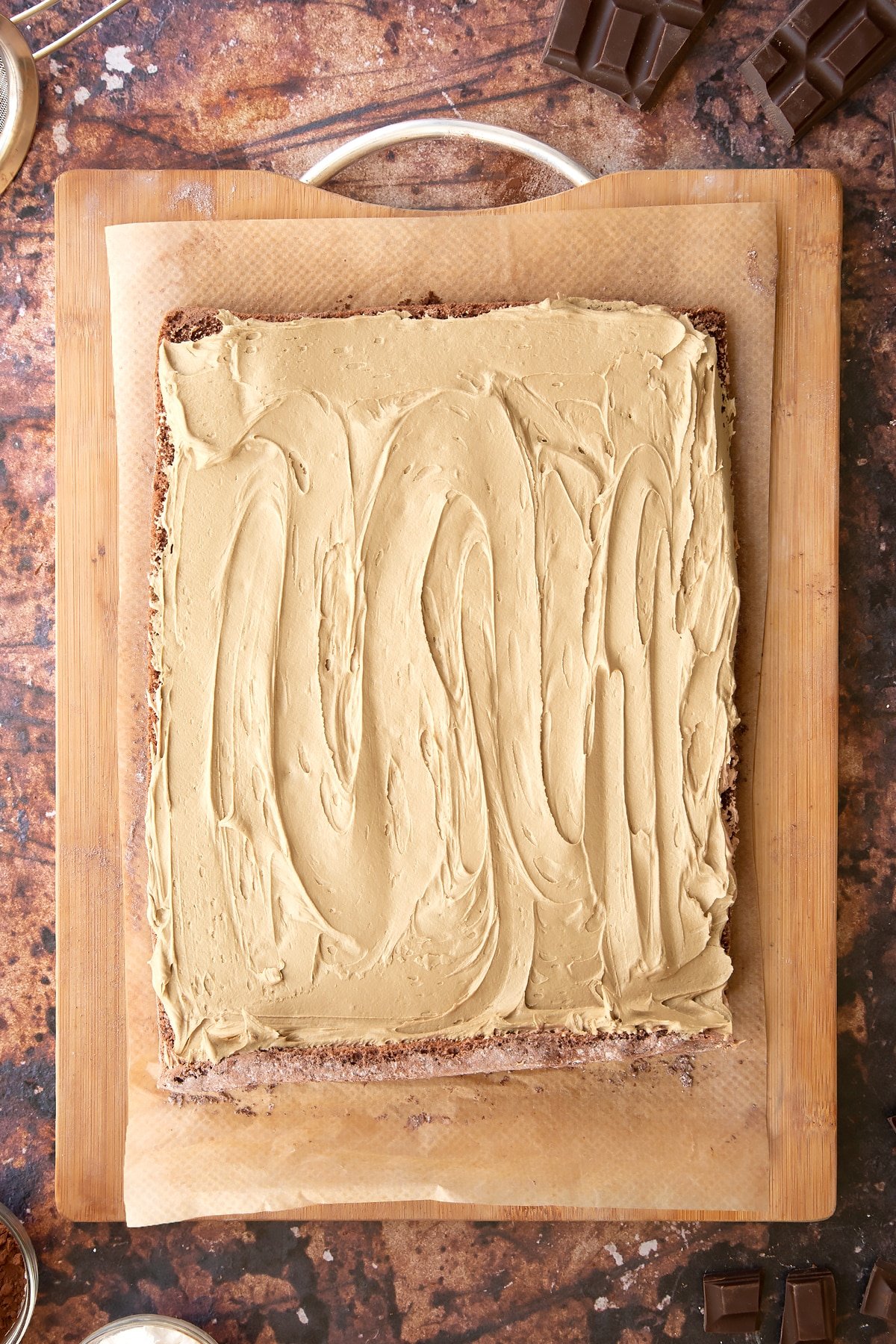
Decorate the Biscoff Swiss roll
Transfer to a serving board or plate.
Lightly soften the Biscoff spread with a burst of about 15 second in the microwave. Drizzle the all over the cake. Allow it to set.
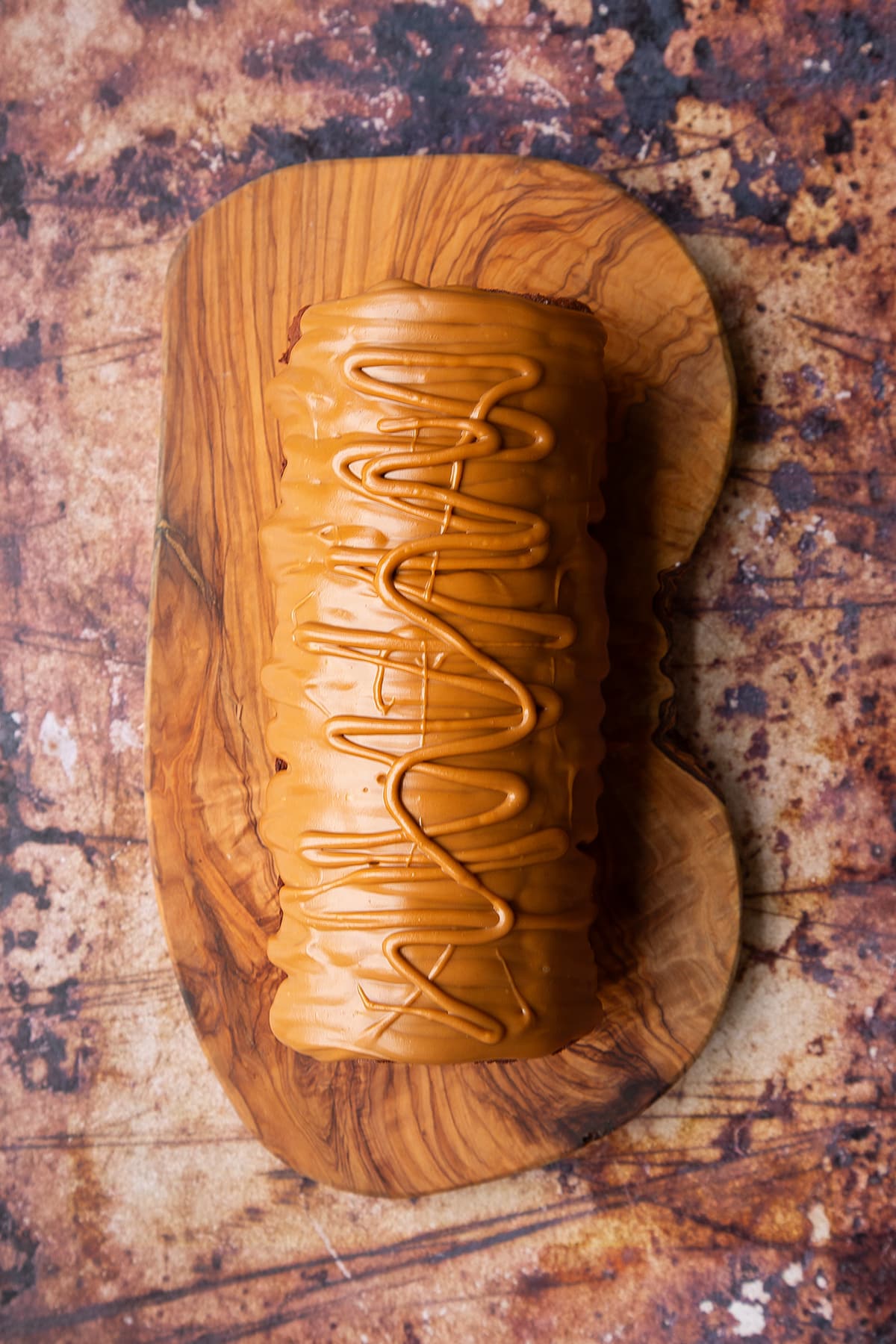
Transfer the remaining frosting to a piping bag fitted with an open star tip and pipe 6-8 rosettes along the top of the roll.
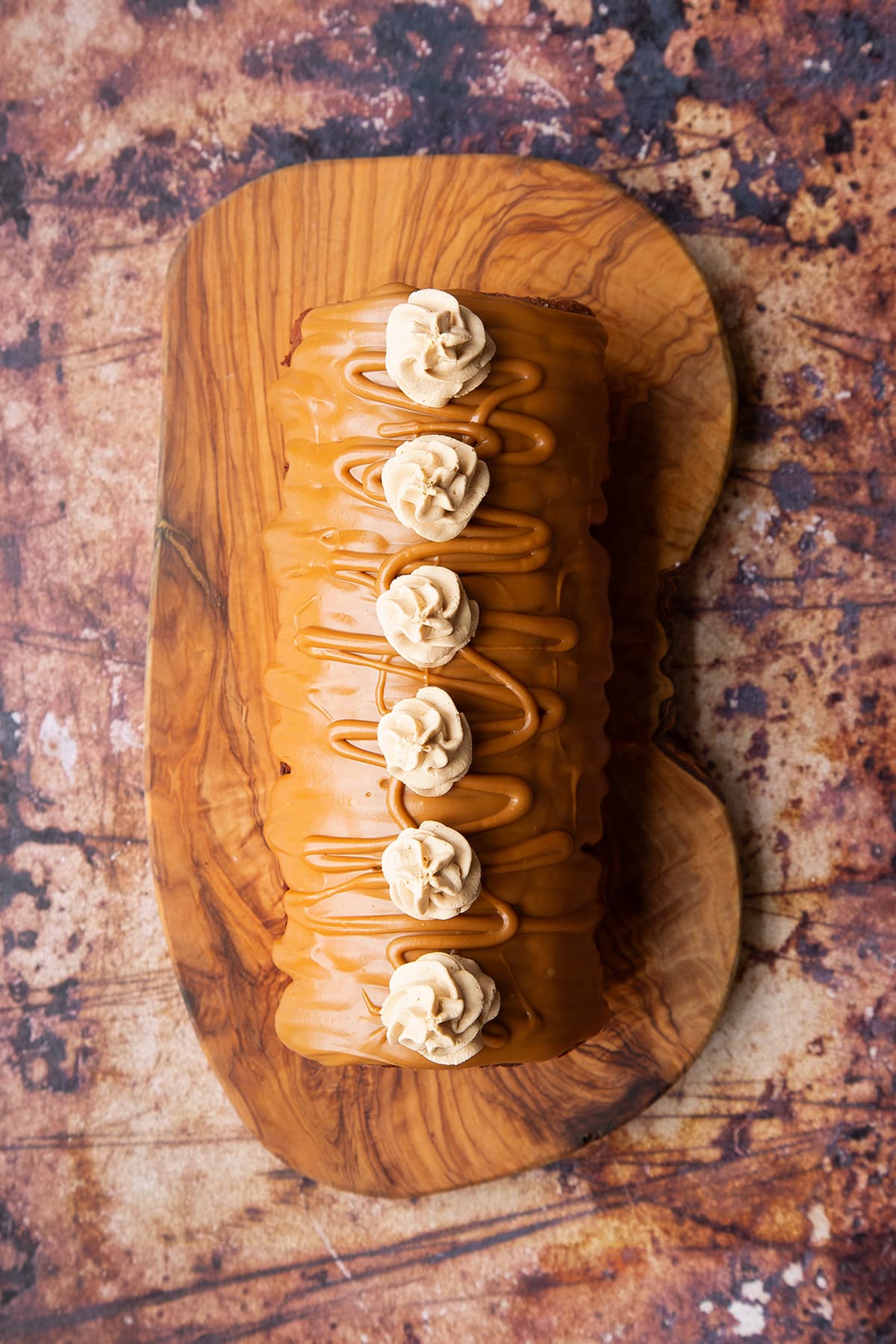
Crush a Biscoff biscuit and sprinkle over the top of the roll.

Push a whole Biscoff biscuit into each rosette.
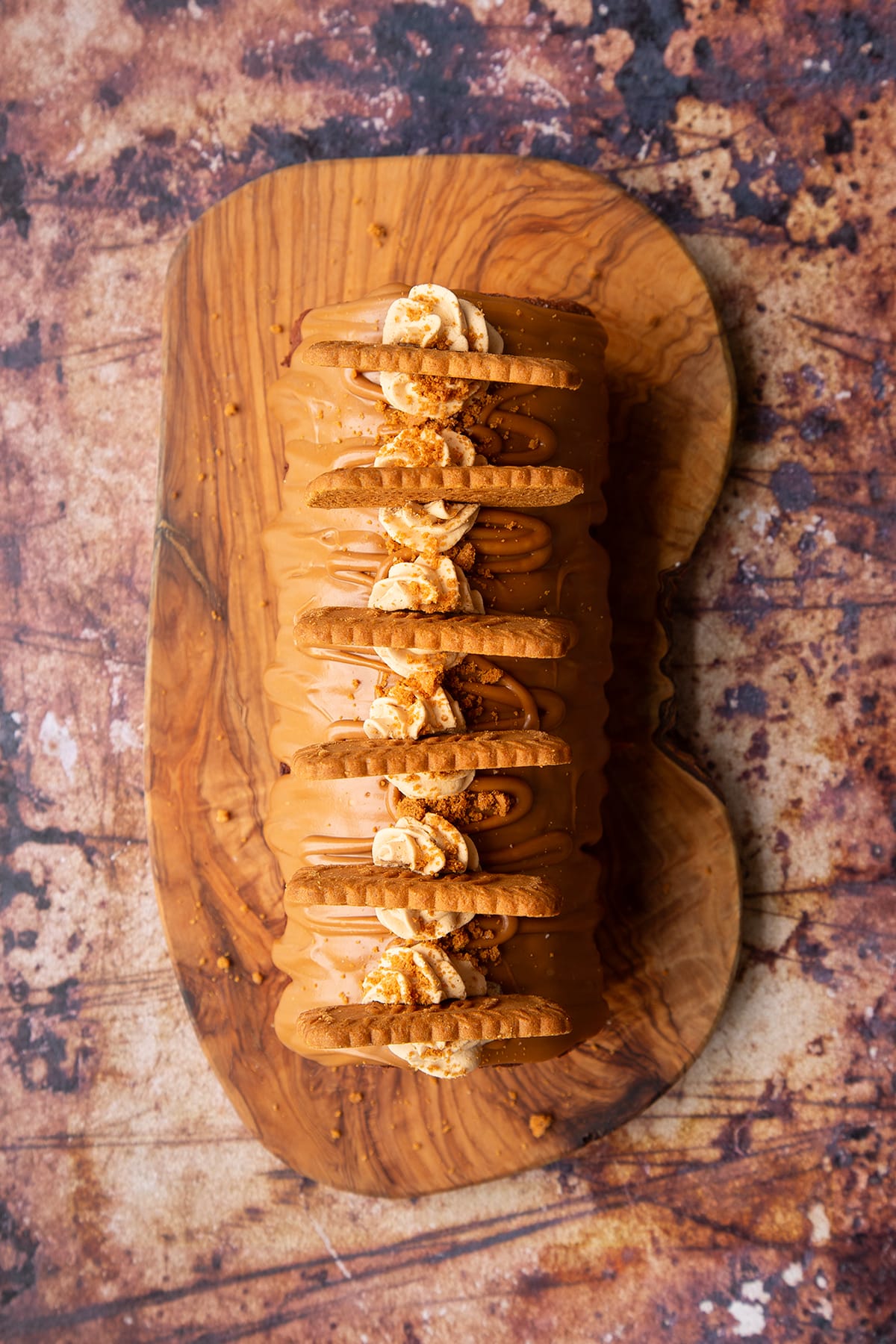
To serve, slice with a sharp, serrated knife to serve.
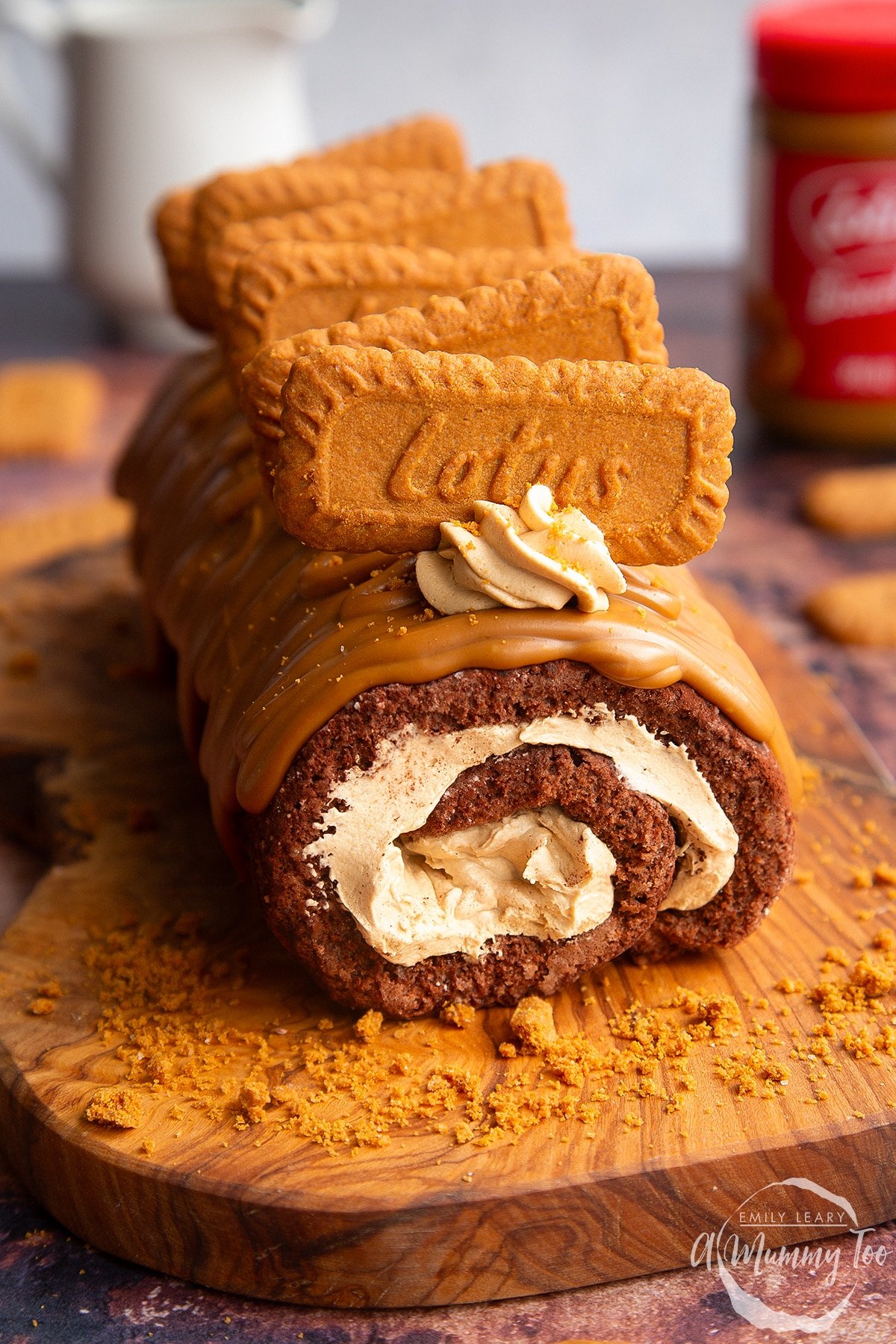
It’s quite a showstopper!
Troubleshooting Biscoff swiss roll issues
How can I make sure the Biscoff Swiss roll is perfectly cooked?
Your chocolate sponge should be perfectly done if you cook it for 8 minutes in a preheated oven 200C (180C fan). However, some ovens are a bit temperamental and can run a little hot or cold, so keep an eye on your sponge from about 5 minutes until it looks set all the way across. When touched with your finger, it should feel just firm. If it still feels wet in the middle, it needs longer.
Why did my sponge come out really thin and dense?
A flat sponge is usually down to a loss of air, which can happen during prep or by leaving the mixture sitting for too long.
When you start to make your sponge, make sure to whip the eggs and sugar until they’re really pale, thick and noticeably increased in volume. This takes about 2 minutes with an electric whisk on full speed.
Don’t skip sifting the flour and cocoa. Cocoa has a tendency to clump and since you’ll need to fold them in very gently with a silicon spatula, it will be very difficult to get rid of dense lumps once they’re added to the batter.
Don’t over mix the batter once the flour and cocoa are added. Just slide your silicone spatula down the side of the bowl to the bottom, lift and turn over. This will gently bring your mixture together in a few turns. As soon as you have an even chocolate shade, stop mixing.
Don’t leave your batter sitting out as it will lose more air over time. Pour it gently into the lined tin, spread carefully, just enough to ease to the edges and level off and then get it straight into a preheated oven.
Why can’t I roll my sponge? Why did my sponge crack when rolled?
The high egg content in the sponge gives it a lovely flexible texture that’s perfect for rolling. Make sure you got all the quantities right and read the answer above regarding properly handling your batter.
Assuming quantities and methods were correct, it could be that you baked your sponge for too long. Remember, the recipe calls for just 8 minutes of baking to bring the sponge to a set state. It doesn’t need to be as firm as, say, a cooked Victoria sponge.
Some ovens run too hot, so if that’s the case with yours, 8 minutes might have proved too long. Get an oven thermometer so that you can see what your oven is doing during cooking.
The other essential part of the method to ensure you can roll your sponge is to do it first when the sponge it hot. It might seem weird to handle a hot cake as with standard sponge, it’s really important to let it cool completely before disturbing, but not so with Swiss roll.
You want to train the sponge to hold a rolled up shape before it cools, so that once you unroll the cooled sponge and fill with buttercream, it rolls back up perfectly. Be sure to sit the sponge on baking paper dusted with cocoa and icing sugar and place a tea towel on top before rolling the paper, hot sponge and tea towel up together. You can prop a weight such as a mug behind the roll, if you wish to stop it unrolling during cooling.
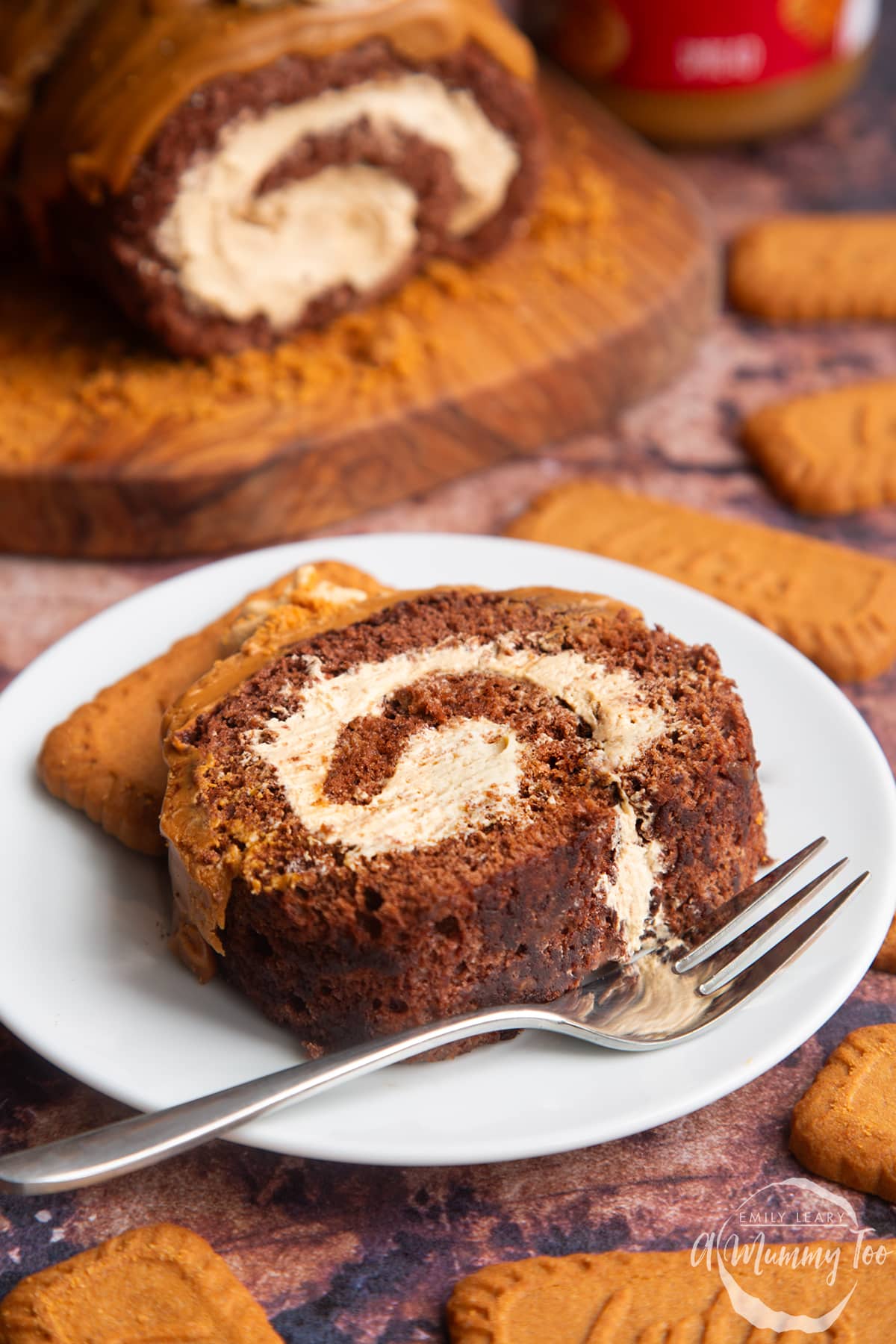
Allergen & dietary information
Is this recipe suitable for vegetarians?
This recipe is totally suitable for vegetarians as it contains no meat, fish or poultry.
Double check all of your ingredients labels to make sure to check that they are suitable for vegetarians. Don’t forget to also check anything extra you intend to serve the recipe with.
Is this recipe suitable for vegans?
This recipe isn’t suitable for vegans as it contains eggs as a key ingredient in the sponge, plus there’s butter and milk in the buttercream filling.
If you wanted to have a go at making a vegan Biscoff cake, the good news is that Biscoff spread and biscuits are vegan! (This information is correct at the time of writing in the UK, November 2023 – always check the label).
However, the eggs would tricky to replace as they do a lot of work in the recipe. Whipping them with the sugar is what gives the sponge structure and they’re also the main source of fat. You could try using 3 tablespoons of aquafaba (the liquid that comes in cans of chickpeas) per egg, but I’m not sure how well that would work.
Personally, I would go and find a vegan chocolate Swiss roll recipe and use that for the sponge, then come back to this recipe for how to put it all together. Feel free to experiment and I’ll come back and update as soon as I’ve had a chance to test a vegan version.
For the butter, you could switch to a vegan butter or baking block. Aim to use one with a fat content of around 80% as this is similar to butter and so you’ll get similar results. I like Flora Plant Butter for this but any brand will do as long as the fat content is where it should be. Avoid lower fat spreads at they tend to have a lot of water in them, which will spoil your buttercream.
And plant milk can replace the small quantity of dairy milk in the buttercream.
Don’t forget to double check all of your ingredients labels to make sure to check that they are suitable for vegans. You should also check anything extra you intend to serve the recipe with.
Is this Biscoff Swiss roll gluten-free?
This Biscoff Swiss roll is not gluten-free as it contains wheat-based self-raising flour in the sponge and in the Biscoff biscuits and spread.
I haven’t tried swapping the flour for a gluten free version, but I always recommend using a good quality brand that will likely be a blend of different flours like rice or oat mixed with a binding agent like xanthan gum which really helps with the texture and, of course, a raising agent if its self-raising flour.
For the gluten-free Biscoff spread, you could try making your own. I haven’t tried this myself, but this recipe by Glutarama looks good.
Although chocolate, cocoa etc shouldn’t naturally contain gluten, some brands may contain traces, so it’s really important to double check all of your ingredients labels to make sure to check that they are gluten-free.
Don’t forget to also check anything extra you intend to serve the recipe with.
Is this Biscoff Swiss roll keto-friendly?
This recipe is high in sugar and so not suitable for a keto diet.
Is this Biscoff Swiss roll recipe healthy?
This is very much a celebration recipe, high in sugar and fat. It can be enjoyed on occasion as part of a healthy diet, rich in a variety of fruits and vegetables.
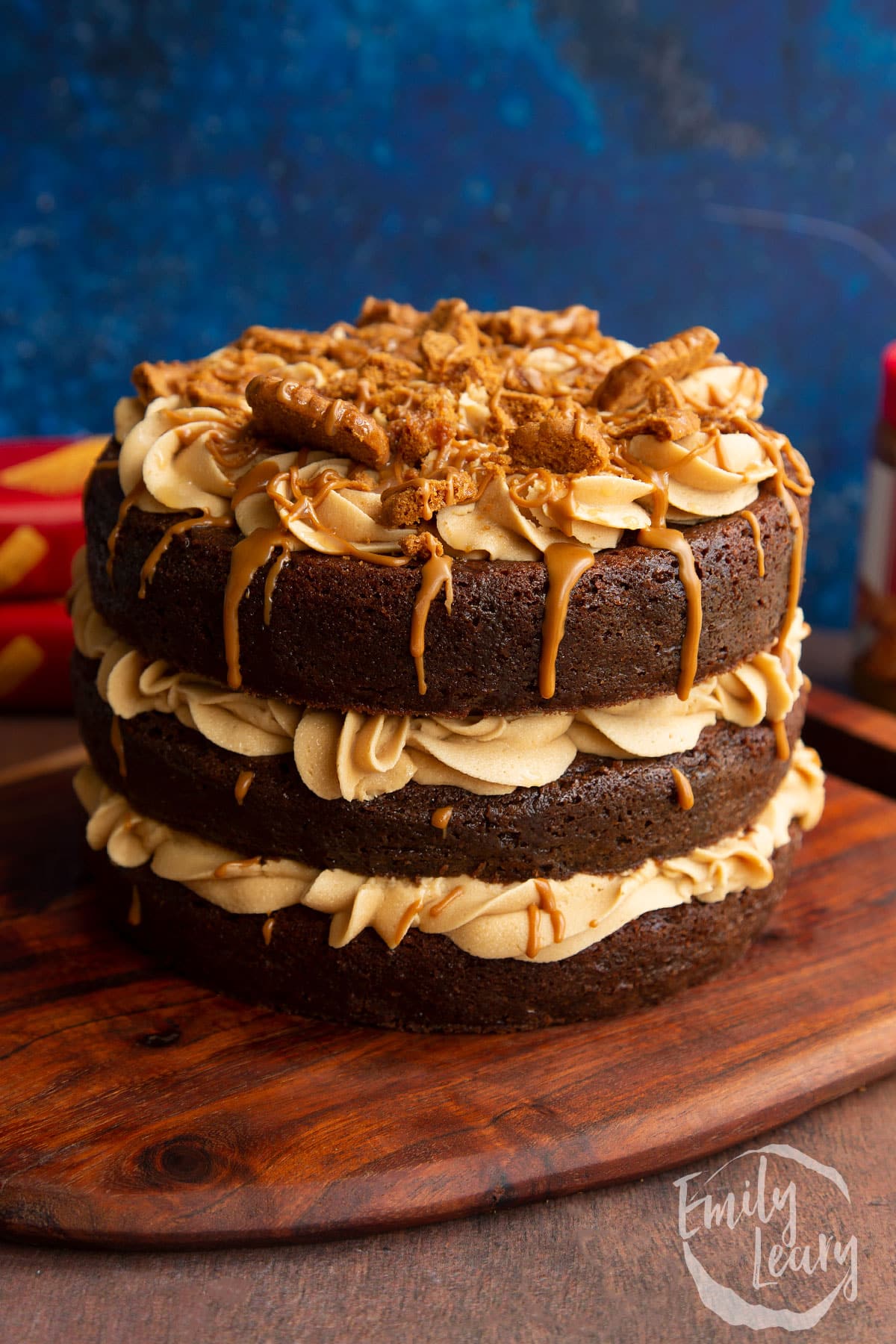
Is Biscoff Swiss roll safe to eat while pregnant?
There is nothing that should present a risk to pregnant people, provided the ingredients are fresh, have been stored correctly, and the recipe is prepared safely, hygienically and cooked properly.
Most dairy butter and milk purchase in the UK is pasteurised, but it’s a good idea to check if you’re unsure as pregnant people should not eat unpasteurised dairy. The NHS explains why here.
Advice regarding eggs can vary depending on where you live as production methods are different in different countries, so please check information local to you. In the UK at the time of writing (Nov 2023), The Advisory Committee on the Microbiological Safety of Food’s advice is that eggs bearing the Red Lion mark of quality are considered safe for pregnant people to eat runny or even raw.
A Mummy Too does not offer medical advice. Please seek help from a medical professional if you need further information or have any concerns.
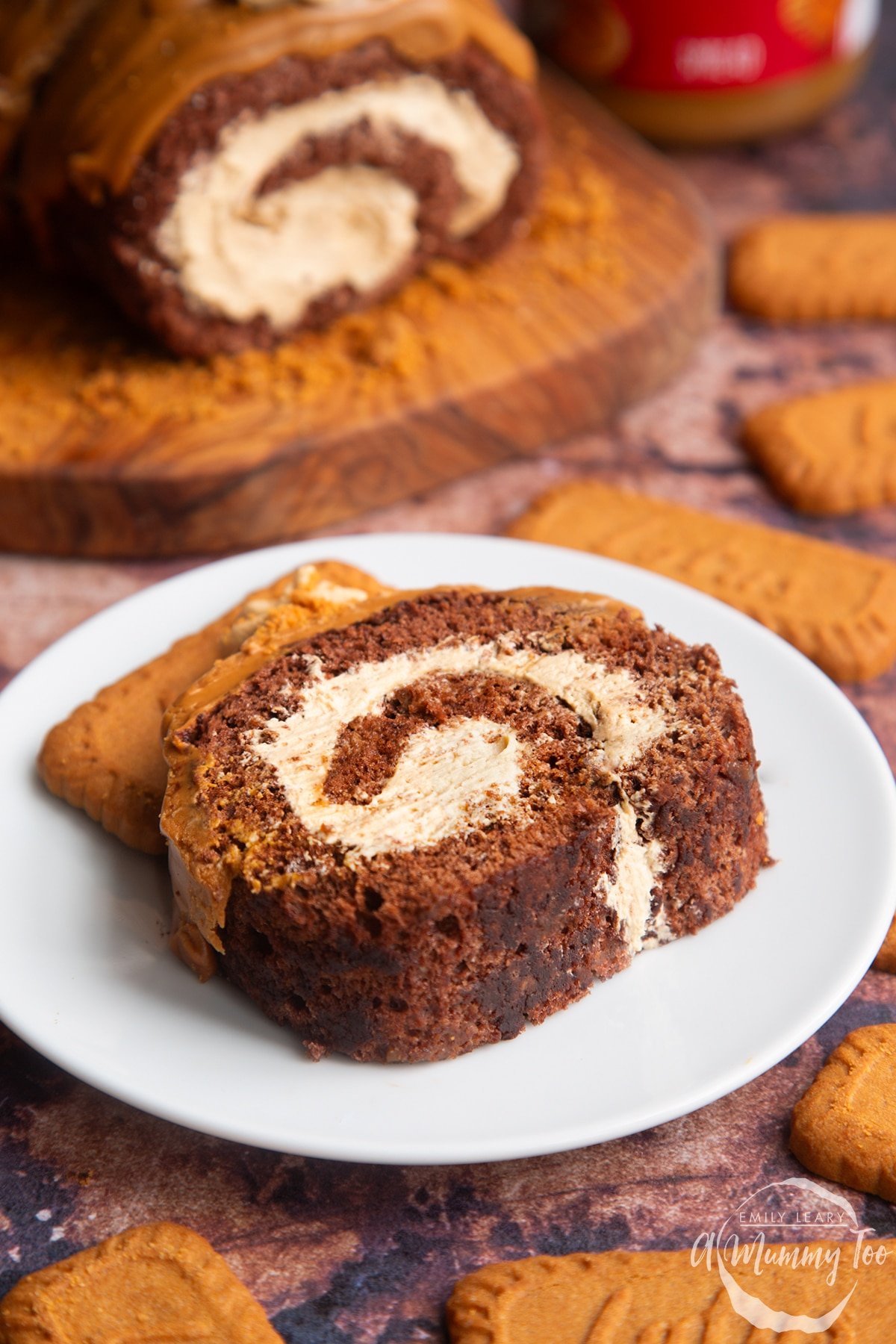
How to store, keep & freeze Biscoff swiss roll?
How long will my Biscoff Swiss roll keep?
If properly stored in a sealed container in a cool, shaded place or in the fridge, your cake should keep for 3-5 days.
In the freezer, leftover slices will keep for up to 3 months.
How should I store my Biscoff Swiss roll?
Keep any leftover caterpillar cake covered in a cool, shaded place or in the fridge. If storing in the fridge, I recommend getting out half an hour before you serve as it tastes better at room temperature.
Can I leave this Biscoff Swiss roll out on the counter?
It’s fine to have your Biscoff Swiss roll out on the counter to serve, but leftovers should be placed in a sealed container or in a cool, shaded place such as a cupboard or pantry.
Can I make a Biscoff Swiss roll ahead?
This recipe keeps well for a few days, so you could certainly make the whole thing ahead, ready to present as part of a celebration the next day.
If you wanted to split the work over two days, you could make the Swiss roll, fill with buttercream and then put the undecorated cake into a container to stay fresh until you’re ready to decorate it with the toppings the next day.
You could also stop at the stage after you’ve covered with Biscoff spread and chill overnight before adding the features in the morning, if you prefer.
Can I keep Biscoff Swiss roll in the refrigerator?
Yes, you can keep this cake in the fridge if you like. Make sure it’s in a sealed container, and I recommend getting it out half an hour before you serve as it tastes better at room temperature.
Can I freeze Biscoff Swiss roll?
A decorated cake like this is always going to look best freshly made, so I wouldn’t recommend freezing whole with the intention of thawing and presenting later. However, if you have leftovers, they freeze really well.
If you intend to freeze some of your Biscoff Swiss roll, make sure to get them into a sealed container and into the freezer on the day of making so they are kept at their best.
You can freeze your leftover Biscoff Swiss roll in one piece if you’ve got the space in your freezer or slice it up.
It’s a good idea to layer a piece of parchment paper between the slices if you are stacking them so that they don’t stick together. This also makes it easier to just get slices out as you need them. They will keep in the freezer for up to 3 months.
What is the best way to defrost Biscoff Swiss roll?
It’s best to defrost any frozen leftovers from your Biscoff Swiss roll in their sealed container in the fridge overnight so they can thaw out slowly. If you’re only defrosting some of the leftovers, transfer them to a fresh container in the fridge to thaw.
Do not refreeze any defrosted leftovers and eat without 24 hours.

Print this Biscoff Swiss Roll Recipe
Biscoff Swiss Roll Recipe
This Biscoff Swiss roll is a gorgeously simple, yet stunningly attractive cake that tastes incredible, with a chocolate sponge and Biscoff buttercream.
Servings: 6 slices
Ingredients
For the sponge
- 3 medium free range eggs
- 100 g (½ cup + 1tbsp) white caster sugar (superfine sugar)
- 100 g (⅔ cup) self-raising white flour (self rising flour)
- 2 tbsp icing sugar (powdered sugar)
To dust
- 1 tbsp cocoa powder (dutch processed)
- 1 tbsp icing sugar (powdered sugar)
For the Biscoff frosting filling
- 100 g (7 tbsp) butter
- 100 g (¾ cup) icing sugar (powdered sugar)
- 100 g (⅓ cup) Lotus biscoff spread smooth
- 1 tbsp milk
To decorate
- 150 g (½ cup) Lotus biscoff spread smooth
- 7 Lotus Biscoff caramelised biscuits
Instructions
Make the Swiss roll sponge
-
Line the Swiss roll tray with baking paper and preheat the oven to 200C (180C fan).
-
Put the eggs and caster sugar in a large mixing bowl. Whisk until thick, pale and considerably increased in volume.
-
Sift in the flour and cocoa. Fold through gently with a silicone spatula.
-
Tip the mixture into the lined tin and gently level off.
-
Bake for 8 minutes until just firm.
Pre-shape the Swiss roll sponge
-
Lay a rectangle of baking paper out on your counter. Sift the cocoa and icing sugar all over the paper.
-
Turn the hot Swiss roll sponge out onto the baking paper, then carefully peel off the paper backing.
-
Lay a clean tea towel on top of the Swiss roll sponge, then carefully roll the sponge up with the tea towel and baking paper. Leave rolled up to cool completely.
Make the Biscoff frosting
-
Put the butter, Biscoff, butter and milk in a large bowl.
-
Whisk until pale and creamy.
Fill the Biscoff Swiss roll
-
Carefully unroll the totally cooled sponge.
-
Spoon approximately 2/3 of the frosting on top, spreading to the edges.
-
Roll back up, this time without taking the baking paper with it.
Decorate the Biscoff Swiss roll
-
Transfer to a serving board or plate.
-
Lightly soften the Biscoff spread with a burst of about 15 second in the microwave. Drizzle the all over the cake. Allow it to set.
-
Transfer the remaining frosting to a piping bag fitted with an open star tip and pipe 6-8 rosettes along the top of the roll.
-
Crush a Biscoff biscuit and sprinkle over the top of the roll.
-
Push a whole Biscoff biscuit into each rosette.
-
To serve, slice with a sharp, serrated knife to serve.
Nutrition
Calories: 647kcal | Carbohydrates: 81g | Protein: 7g | Fat: 34g | Saturated Fat: 13g | Polyunsaturated Fat: 1g | Monounsaturated Fat: 4g | Trans Fat: 1g | Cholesterol: 118mg | Sodium: 263mg | Potassium: 68mg | Fiber: 1g | Sugar: 56g | Vitamin A: 540IU | Calcium: 23mg | Iron: 1mg
* Note: nutritional information is estimated, based on publicly available data. Nutrient values may vary from those published. Information on this website should not be taken as medical advice. Cuisines identify the primary region of inspiration for a dish.
More Biscoff recipes to try
This Biscoff rocky road is creamy, crunchy, chewy and delicious! It’s made with white chocolate, which pairs beautifully with the distinctive flavours of Biscoff.
Get ready to experience the pure delight of this stunningly delicious Biscoff loaf cake, featuring a tender Biscoff sponge and creamy Biscoff buttercream.
This irresistible Lotus Biscoff birthday cake is a dreamy delight for Biscoff lovers, with layers of tender Biscoff sponge and creamy Biscoff buttercream.
These biscoff millionaires shortbread are made up of layers and layers of biscoff perfection. And they’re very easy to make!
These Lotus Biscoff cupcakes feature a tender Biscoff sponge and a luscious Biscoff buttercream, topped with a Biscoff cookie and a drizzle of Biscoff spread.
6 FUN recipes to make with kids – a FREE family baking eBook!
Have a free copy of my family baking eBook! With 6 easy recipes and bonus activities to get kids into the kitchen – and keep them busy for hours!




